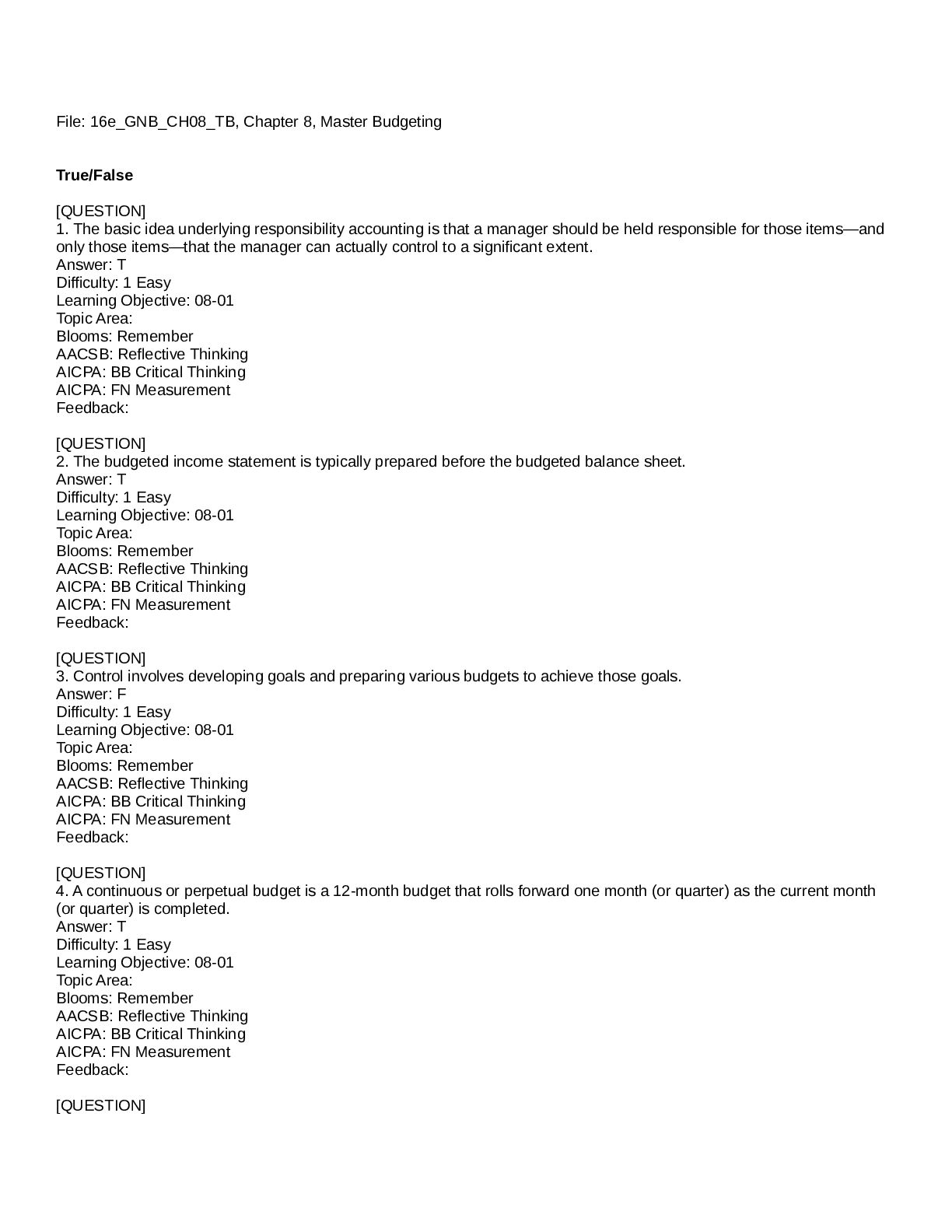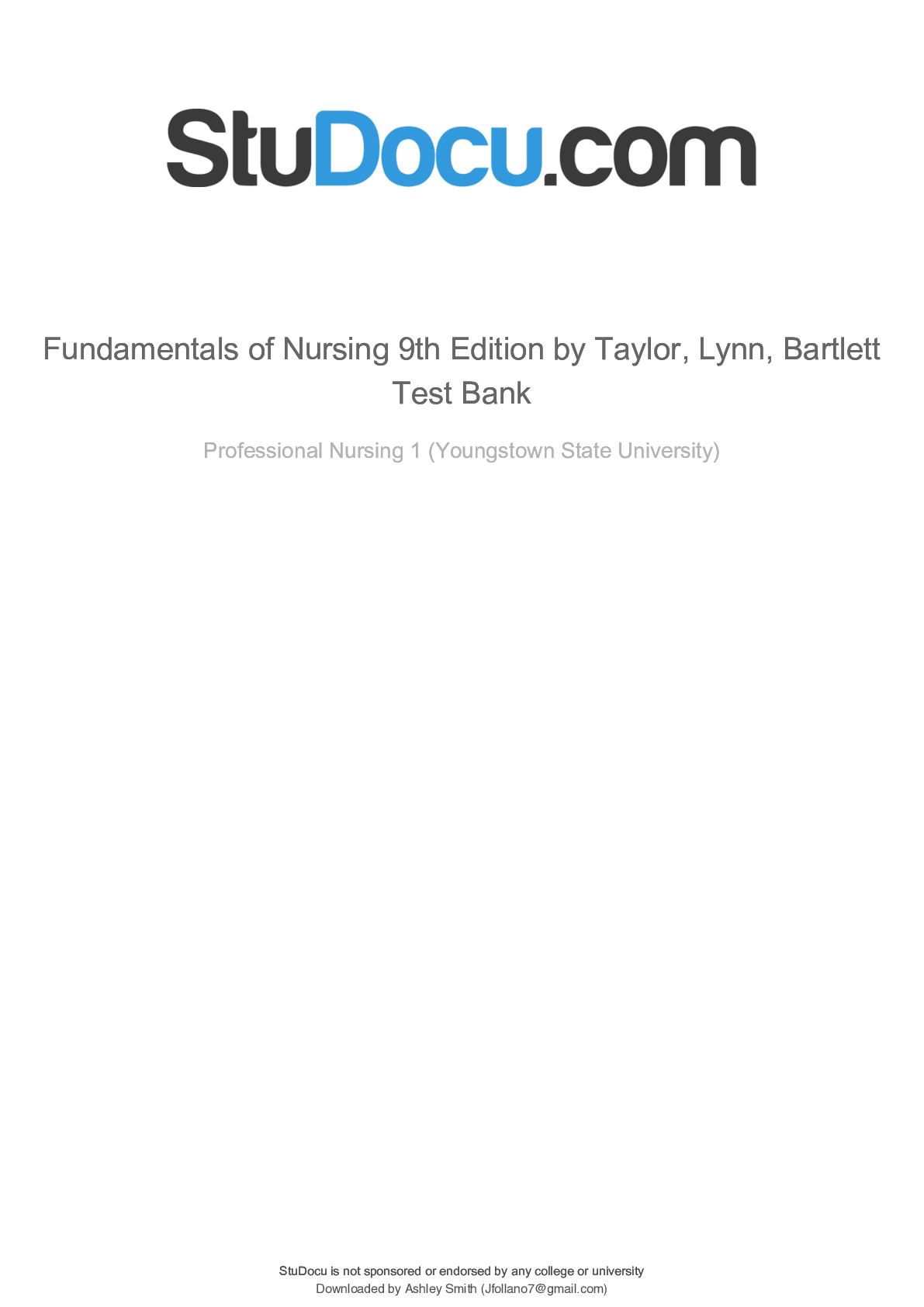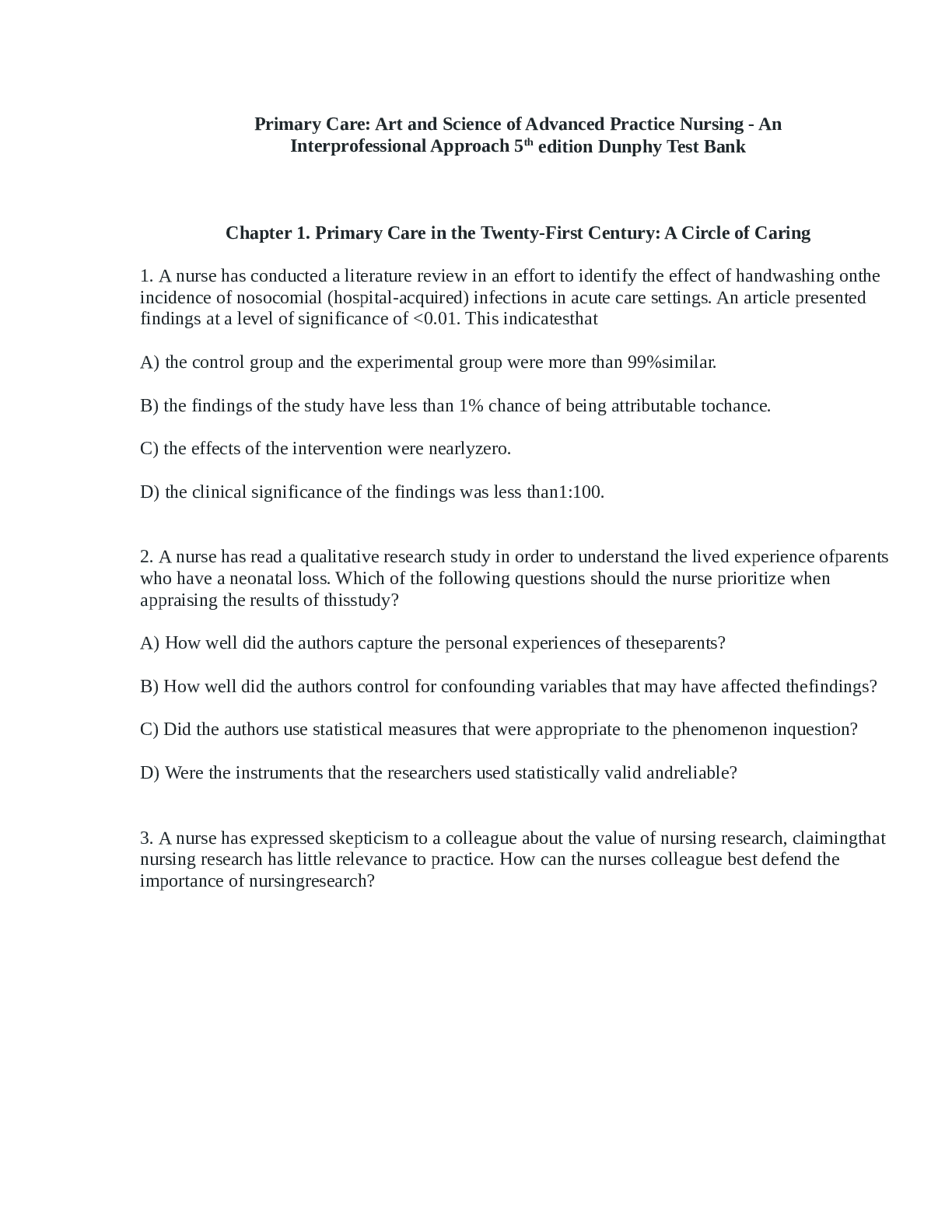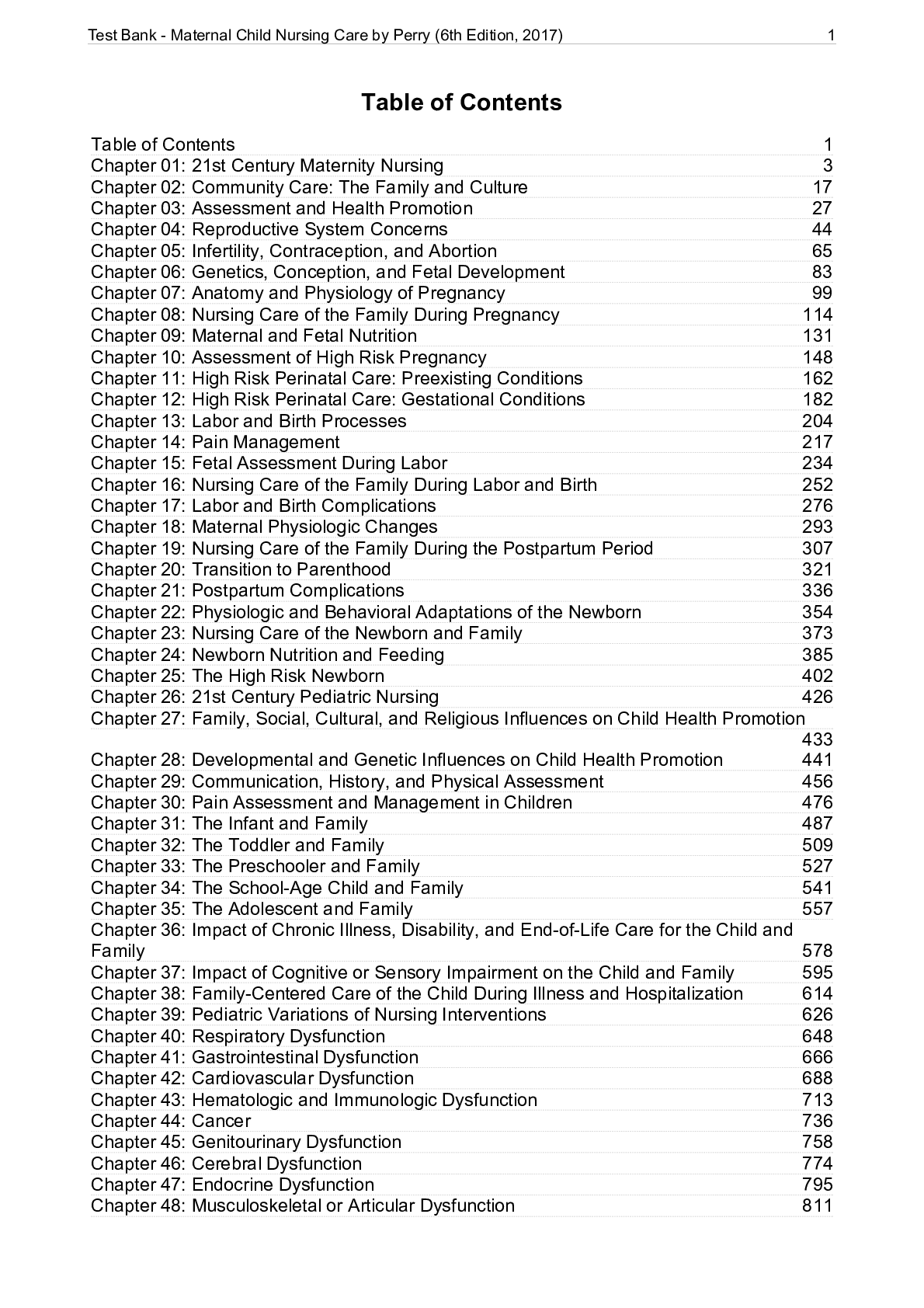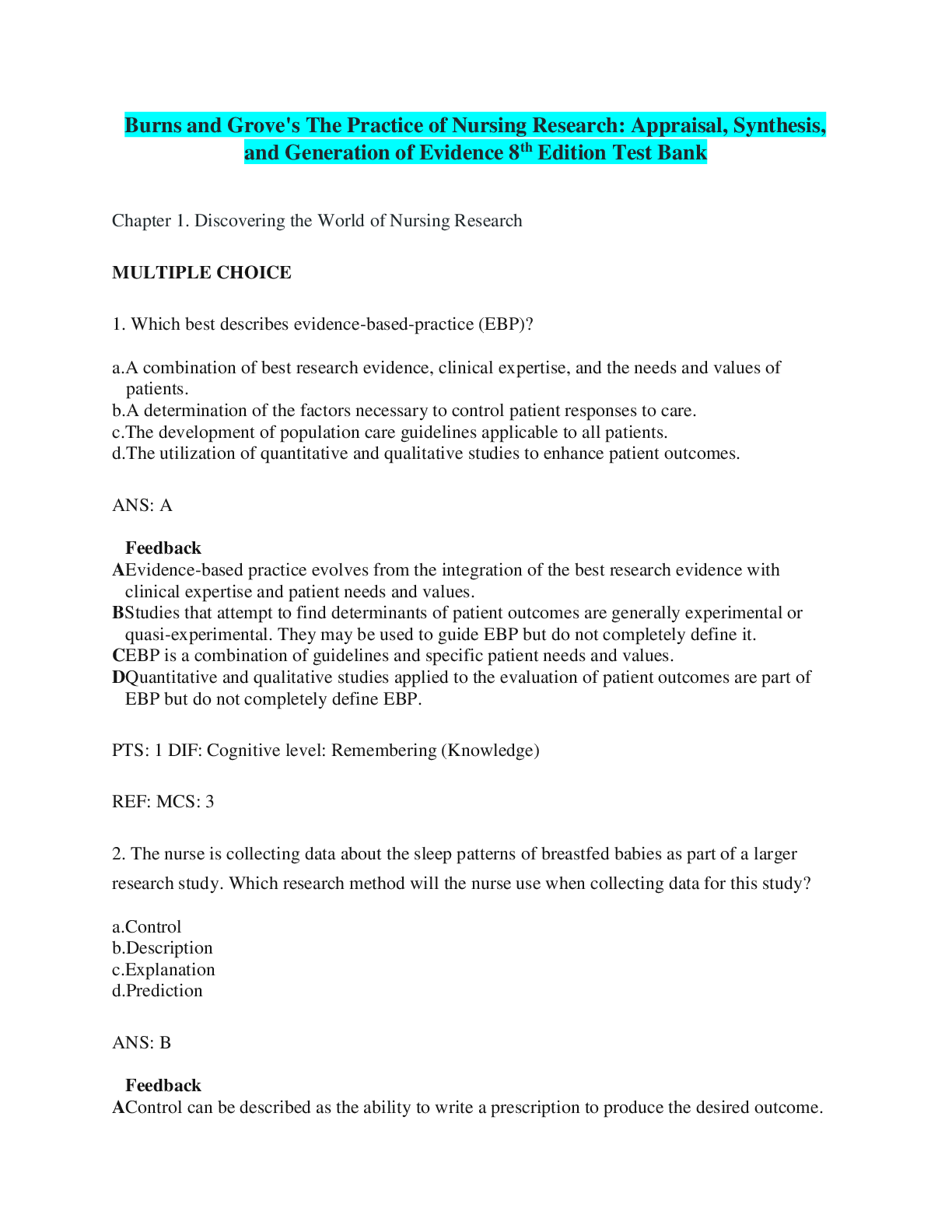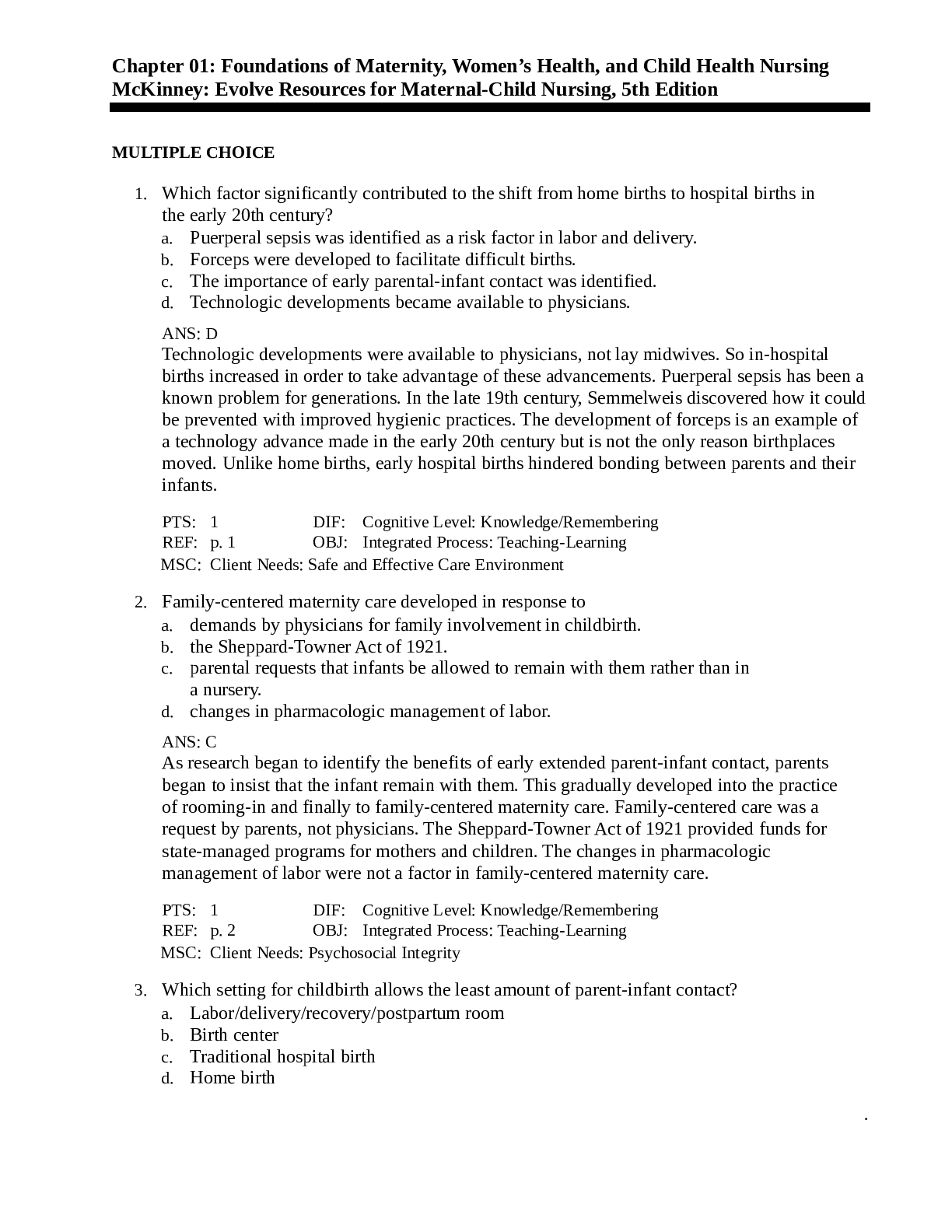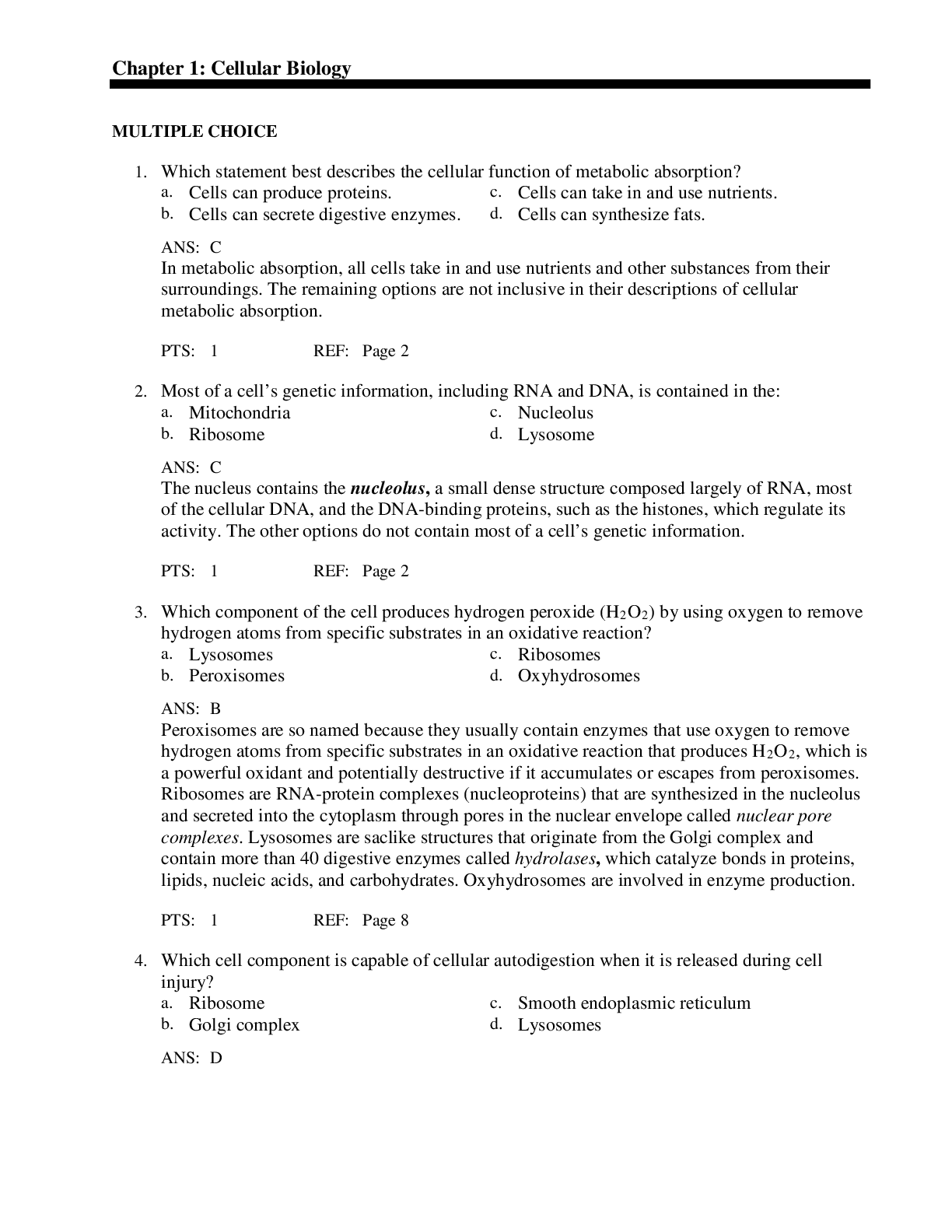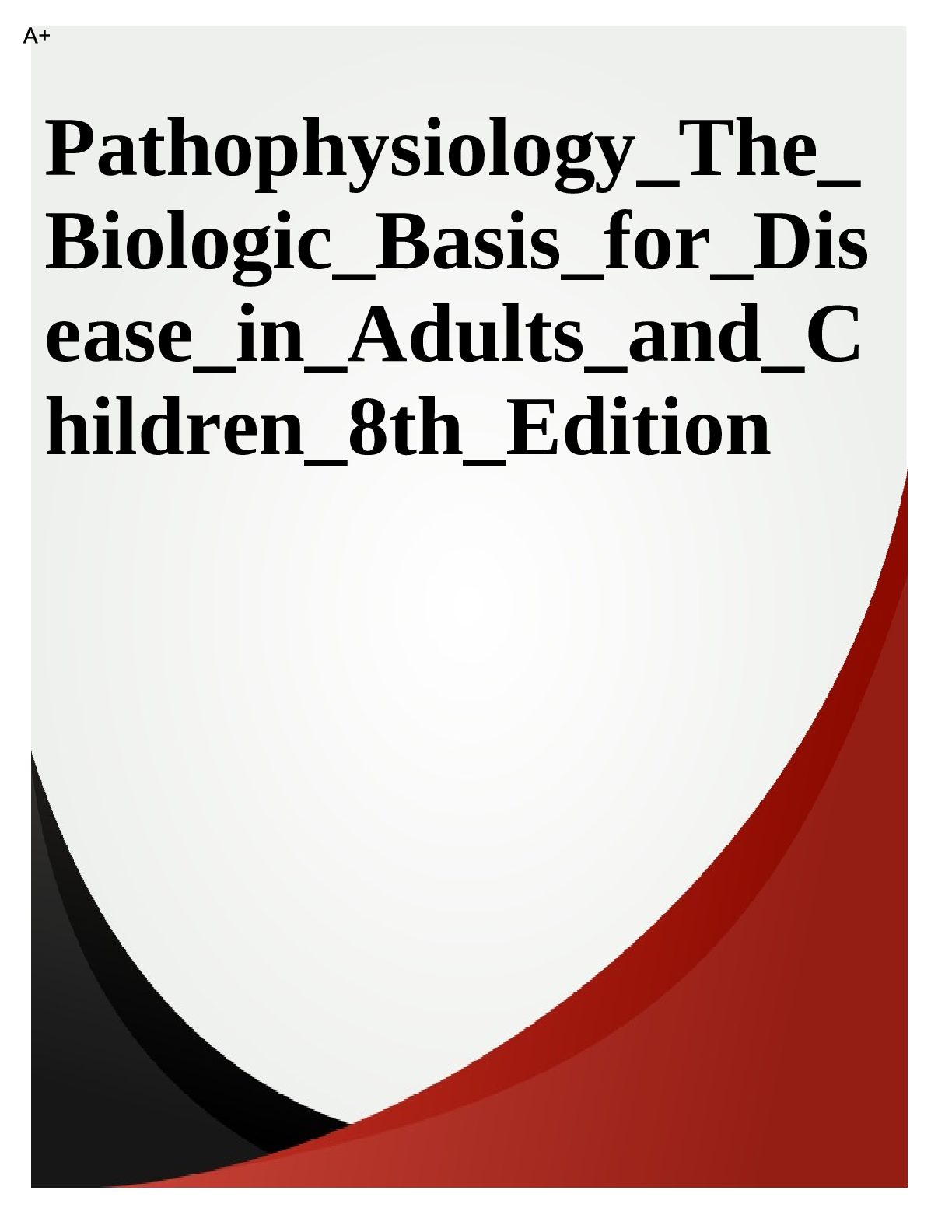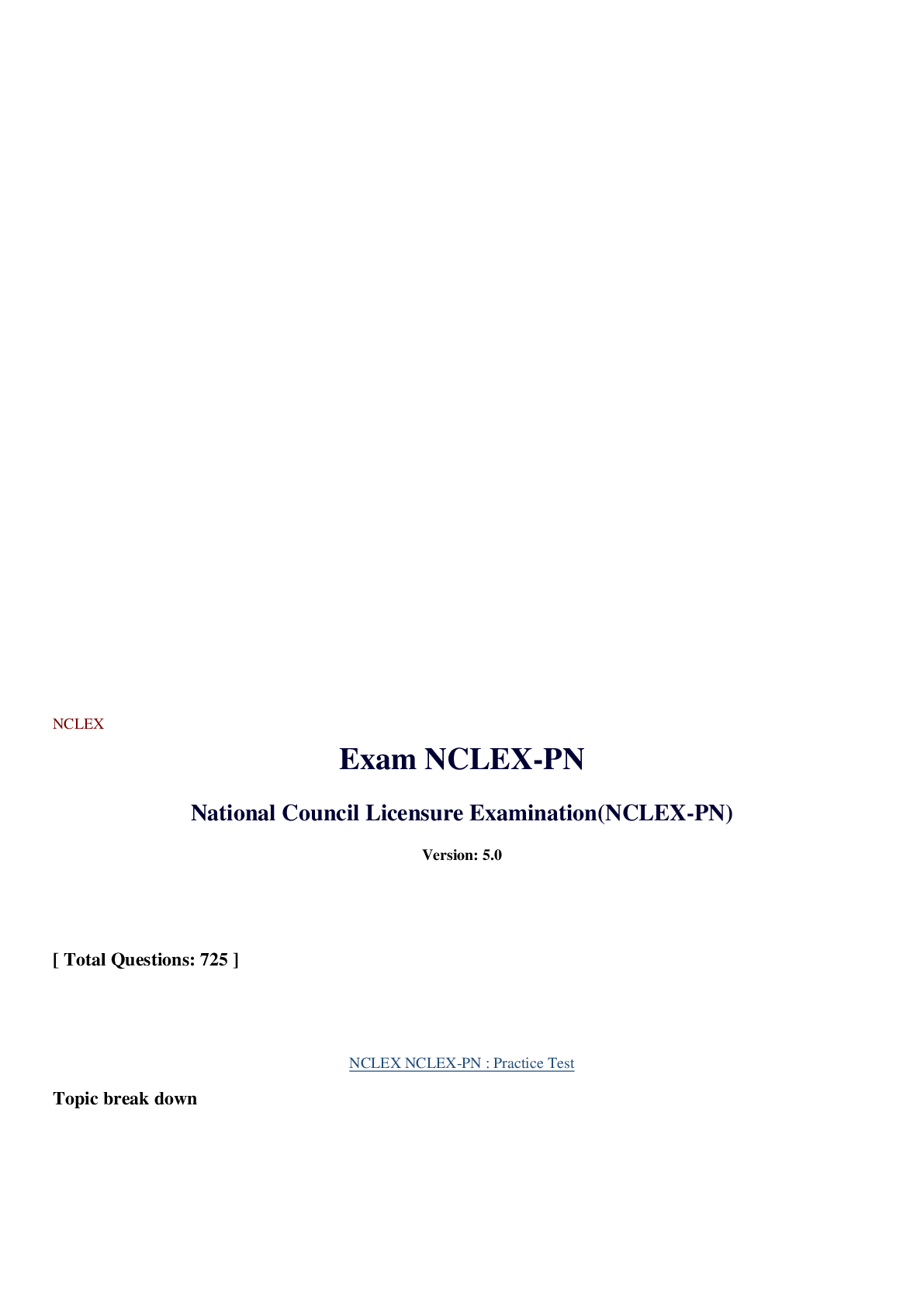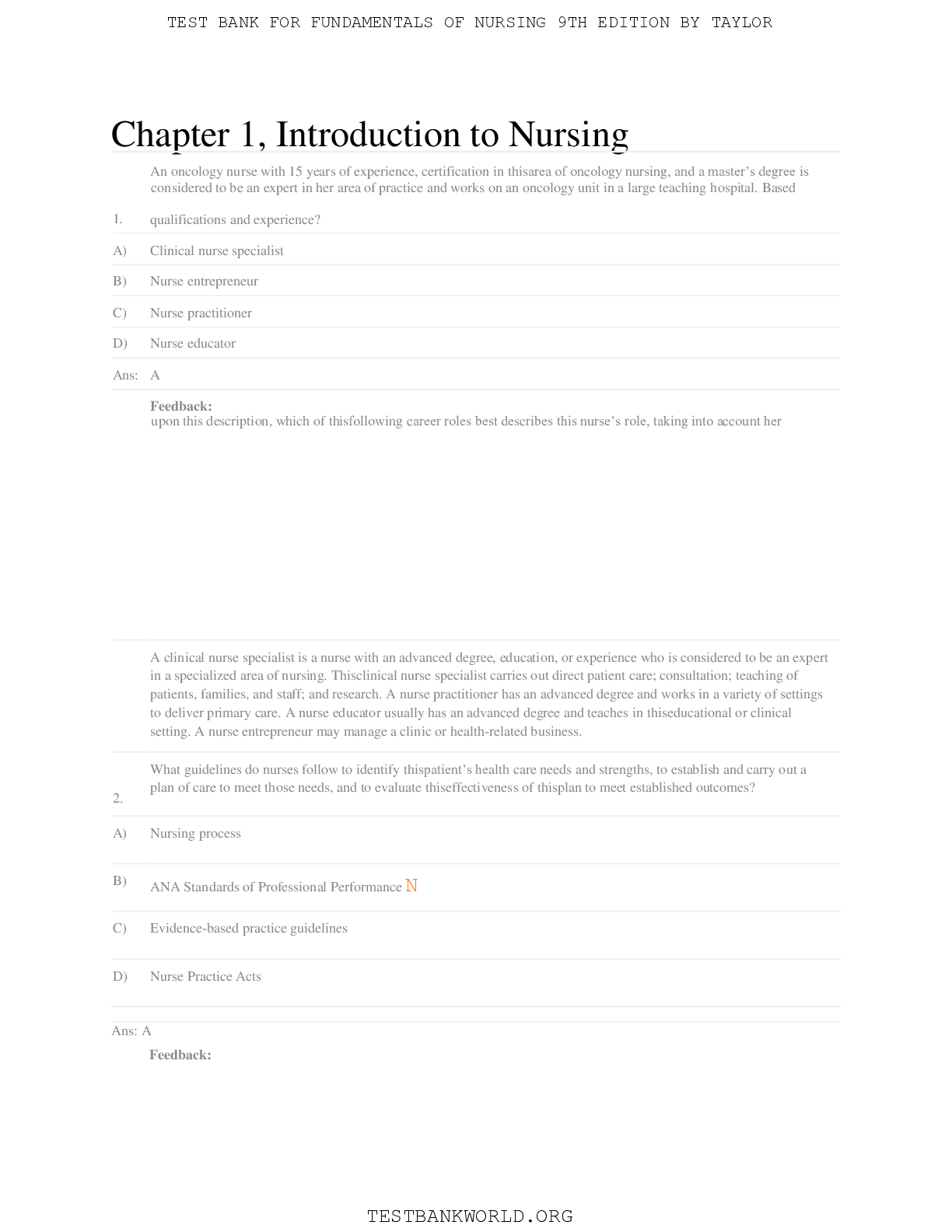*NURSING > TEST BANK > Fundamentals of Nursing Potter Perry Test Bank > complete A+ guide; all chapters questions/answers(d (All)
Fundamentals of Nursing Potter Perry Test Bank > complete A+ guide; all chapters questions/answers(deeply elaborated)
Document Content and Description Below
Fundamentals of Nursing 10th Edition Potter Perry Test Bank Chapter 1. Nursing Today MULTIPLE CHOICE 1. Contemporary nursing practice is based on knowledge generated through nursing theories. Flor... ence Nightingales theory introduced the concept that nursing care focuses on: 1 Psychological needs 2 A maximal level of wellness 3 Health maintenance and restoration 4 Interpersonal interactions with the client ANS: 3 Florence Nightingale believed the role of the nurse was to put the clients body in the best state in order to remain free of disease or to recover from disease. Although Florence Nightingale may have addressed meeting the psychological needs of her clients, it is not the focus of her theory. The goal of Nightingales theory is to facilitate the bodys reparative processes by manipulating the clients environment. Florence Nightingale thought the human body had reparative properties of its own if it was cared for in a way to recover from disease. Her theory did not focus on achieving a maximal level of wellness. Florence Nightingale believed the nurse was in charge of the clients health. Although she interacted with her clients by reading to them, her theory of nursing care did not focus upon interpersonal interactions. DIF: A REF: 2 OBJ: Knowledge TOP: Nursing Process: Assessment MSC: NCLEX test plan designation: Safe, Effective Care Environment/Coordinated Care 2. Nursing education programs in the United States may seek voluntary accreditation by the appropriate accrediting commission council of the: 1 National League for Nursing 2 American Nurses Association 3 Congress for Nursing Practice 4 International Council of Nurses ANS: 1 The National League for Nursing (NLN) is the professional nursing organization concerned with nursing education. The NLN provides accreditation to nursing programs that seek and meet the NLN accreditation requirements. The American Nurses Association (ANA) is concerned with the nursing profession and issues affecting health care, including standards of care. The Congress for Nursing Practice is the part of the ANA concerned with determining the legal aspects of nursing practice, the public recognition of the importance of nursing, and the impact of trends in health care on nursing practice. The International Council of Nurses (ICN) is concerned about issues of health care and the nursing profession, including the provision of an international power base for nurses. DIF: A REF: 8 OBJ: Knowledge TOP: Nursing Process: Assessment MSC: NCLEX test plan designation: Safe, Effective Care Environment/Coordinated Care 3. The minimum educational requirement for a nurse practitioner is: 1 Diploma in nursing 2 Masters in nursing 3 Doctorate in nursing 4 Baccalaureate in nursing ANS: 2 A masters degree is nursing is required to become a nurse practitioner. Diploma programs in nursing require 3 years of education after which the graduate may become a registered nurse, but not a nurse practitioner. Doctoral programs focus on the application of research findings to clinical practice. The doctoral degree is beyond the masters degree. The baccalaureate degree program generally requires 4 years of study in a college or university, after which the graduate may become a registered nurse, not a nurse practitioner. DIF: A REF: 8 OBJ: Knowledge TOP: Nursing Process: Assessment MSC: NCLEX test plan designation: Safe, Effective Care Environment/Coordinated Care 4. A group that lobbies at the state and federal level for advancement of nursings role, economic interest, and health care is the: 1 State Board of Nursing 2 American Nurses Association 3 American Hospital Association 4 National Student Nurses Association ANS: 2 The American Nurses Association (ANA) hires lobbyists at the state and federal level to promote the advancement of health care and the economic and general welfare of nurses. State Boards of Nursing primarily focus on licensure of nurses within their own state. The American Hospital Association does not focus on nurses economic issues and the advancement of the role of nurses. The National Student Nurses Association focuses on issues of importance for nursing students. DIF: A REF: 8 OBJ: Comprehension TOP: Nursing Process: Assessment MSC: NCLEX test plan designation: Safe, Effective Care Environment/Coordinated Care 5. A nurse moves from Seattle to Boston and begins working in a hospital. The most important factor for the nurse to consider when moving to another state is the: 1 Massachusetts Nurse Practice Act 2 Standard for nursing practice in Boston 3 Clinical ladder of mobility in the new hospital 4 Requirement for continuing education units (CEU) in Massachusetts ANS: 1 Although most states have similar practice acts, each individual state has its own Nurse Practice Act that regulates the licensure and practice of nursing within that state. Knowledge of the Nurse Practice Act is necessary to provide safe and legal nursing care. Standards of nursing practice are not specific to a city, but rather to the profession itself. Although the clinical ladder of mobility may be of interest in regard to professional advancement, it is not the most important factor when practicing nursing in another state. Knowledge of the Nurse Practice Act in order to provide safe and legal nursing care is of higher importance. Regardless of where a nurse practices, the nurse should strive to remain current. DIF: C REF: 8 OBJ: Analysis TOP: Nursing Process: Assessment MSC: NCLEX test plan designation: Safe, Effective Care Environment/Coordinated Care 6. A nurse is caring for a client who has chronic renal failure. The nurse states, We will do everything possible to return you to the optimum level of self-care possible. In coordinating an approach to best meet the needs of this client, the nurse is fulfilling the role of: 1 Manager 2 Educator 3 Counselor 4 Communicator ANS: 1 The nurse, in caring for this client, will coordinate the activities of other members of the health care team. This client may require the assistance of a nursing assistant to provide personal care until the client is less fatigued. A nutritionist may be necessary for diet evaluation, planning, and teaching. A nurse may provide education on the dialysis therapy and perform the skill necessary until the client is able to do so independently. The nurse may include patient teaching in the clients care, but more is required to meet the needs of this client. The nurse is not performing in the role of counselor. Clear communication will be necessary for the client to understand self-care measures regarding dialysis. The role of communicator does not, however, entirely meet the clients physical needs at this time. DIF: A REF: 10 OBJ: Comprehension TOP: Nursing Process: Planning MSC: NCLEX test plan designation: Safe, Effective Care Environment/Coordinated Care 7. Nurses have the opportunity to work in a wide variety of health care agencies around the world. The practice setting where the majority of nurses continue to work is: 1 Acute care 2 Home care 3 Long-term care 4 Ambulatory care ANS: 1 Most nurses provide direct client care in the hospital setting. Although opportunities for providing patient care in the clients home are increasing, the majority of nurses are not employed in this setting. The majority of nurses do not work in nursing homes or extended care settings. Significantly fewer nurses work in an ambulatory care setting. DIF: A REF: 10 OBJ: Knowledge TOP: Nursing Process: Assessment MSC: NCLEX test plan designation: Safe, Effective Care Environment/Coordinated Care 8. A client is receiving Dilantin to prevent seizure activity. To which allied health care professional should the nurse refer this client in order to minimize the challenges this condition creates? 1 Physical therapist 2 Physicians assistant 3 Respiratory therapist 4 Occupational therapist ANS: 4 An occupational therapist is a person who provides assessment and intervention to ameliorate physical and psychological deficits that interfere with the performance of activities and tasks of living, including ones employment. A physical therapist is responsible for the patients musculoskeletal system. A physical therapist may use exercises as an intervention to improve a clients mobility. A respiratory therapist provides treatment to preserve or improve pulmonary function. A physicians assistant performs tasks usually done by physicians and works under the direction of a supervising physician. DIF: C OBJ: Analysis TOP: Nursing Process: Planning MSC: NCLEX test plan designation: Safe, Effective Care Environment/Coordinated Care 9. The Goldmark Report concluded that: 1 Nursing roles and responsibilities required clarification 2 A theory-based curriculum was necessary for accreditation 3 Nursing education programs must be affiliated with universities 4 Increased financial support should be provided for nursing education ANS: 4 In 1923 the Goldmark Report identified the need for increased financial support to university- based schools of nursing. The National Commission on Nursing and Nursing Education Report of 1965 recommended that nursing roles and responsibilities be clarified in relation to other health care professionals. In 1975 the National League for Nursing required theory-based curriculum for accreditation. The Brown Report of 1948 concluded that all nursing education programs should be affiliated with universities and should have their own budgets. DIF: A REF: 3 OBJ: Knowledge TOP: Nursing Process: Assessment MSC: NCLEX test plan designation: Safe, Effective Care Environment/Coordinated Care 10. In 1893 Lillian Wald and Mary Brewster made significant contributions to the nursing profession through their work involving the: 1 Henry Street Settlement in New York 2 First training school in Toronto, Canada 3 Training school at Johns Hopkins in Baltimore 4 Development of the American Journal of Nursing ANS: 1 In 1893 Lillian Wald and Mary Brewster opened the Henry Street Settlement, which was the first community health service for the poor. The first nurses training school in Canada was founded in St. Catherines, Ontario, in 1874. In 1894 Isabel Hampton Robb was the first superintendent of the Johns Hopkins Training School in Baltimore, Maryland. Isabel Hampton Robb was one of the original founders of the American Journal of Nursing. DIF: A REF: 3 OBJ: Comprehension TOP: Nursing Process: Assessment MSC: NCLEX test plan designation: Safe, Effective Care Environment/Coordinated Care 11. To obtain a certification in a specialty area, the nurse will have to complete: 1 A request for state approval 2 A graduate degree in nursing 3 An examination and the minimum practice requirements 4 A general examination given to all nurses seeking certification ANS: 3 Set minimum practice requirements are based on the certification the nurse is seeking. After passing the initial examination, the nurse maintains certification by ongoing continuing education and clinical or administrative practice. Individual states do not grant certification by request. Certification in a specialty area requires passing the examination for certification in that area and meeting minimum practice requirements. A masters degree in nursing is not required for certification in a specialty area. A specialized examination is given according to the specific area of nursing practice in which certification is being sought. DIF: A REF: 9 OBJ: Knowledge TOP: Nursing Process: Assessment MSC: NCLEX test plan designation: Safe, Effective Care Environment/Coordinated Care 12. In the ANA Standards of Professional Performance, which one of the following is a specific measurement criterion for The nurses decisions and actions on behalf of clients are determined in an ethical manner? 1 Acts as client advocate 2 Participates in the collection of client data 3 Seeks experiences to maintain clinical skills 4 Consults with appropriate health care providers ANS: 1 As a client advocate, the nurse protects the clients human and legal rights and provides assistance in asserting those rights if the need arises. Performing in the role of patient advocate fulfills a measurement criterion for the professional performance standard of ethics. Participating in data collection is a measurement criterion for the professional performance standard of quality of practice. The nurse who seeks experiences to maintain clinical skills is fulfilling a measurement criterion for the professional performance standard of education. Consulting with health care providers is a measurement criterion for the professional performance standard of collaboration. 13. In looking at the nineteenth century, the growth of professional nursing was stimulated by: 1 The Civil War 2 Federal legislation 3 Florence Nightingale 4 The womens suffrage movement ANS: 1 The Civil War stimulated the growth of nursing in the United States. Nurses were in demand to tend to the soldiers of the battlefield. Throughout history, nurses and their professional organizations have lobbied for health care legislation to meet the needs of clients. However, legislation was not responsible for the growth of nursing in the nineteenth century. Although Florence Nightingale had great impact on the practice of nursing, she was not the cause for the growth of nursing in the United States during the nineteenth century. The womens movement has encouraged nurses to seek greater autonomy and responsibility in providing care, and has caused female clients to seek more control of their health and lives. The womens movement was not responsible for the growth of nursing in the nineteenth century. DIF: A REF: 3 OBJ: Comprehension TOP: Nursing Process: Assessment MSC: NCLEX test plan designation: Safe, Effective Care Environment/Coordinated Care 14. Which of the following educational activities is an example of in-service education? 1 A workshop given at a nursing convention on malpractice 2 A program on new cardiac medications provided at a local hospital 3 Credit courses in communication offered at the community college 4 Noncredit courses on nursing issues available through the internet ANS: 2 An in-service education program is instruction or training provided by a health care agency or institution for its employees. A workshop at a nursing convention is an example of a continuing education program. Credit courses at a college are examples of continuing education that could possibly by applied toward furthering ones degree. Noncredit courses offered via the internet are an example of a continuing education program. 15. Nurses need to be aware of current trends in the health care delivery system in order to respond in educational preparation and practice. A major trend that is influencing nursing practice today is: 1 Decreased client acuity 2 Increased hospital stays 3 Decreased emphasis on health promotion 4 Increased incidence of chronic disease processes ANS: 4 In recent decades, there is a higher incidence of chronic, long-term illness. With shortened hospital stays, client acuity has increased, not decreased. Hospital stays have decreased, not increased. Lengths of stay have shortened with a trend toward home care, and health promotion and illness prevention. With increased public awareness and rising health care costs, greater emphasis has been placed on health promotion and illness prevention. DIF: A REF: 4 OBJ: Comprehension TOP: Nursing Process: Assessment MSC: NCLEX test plan designation: Safe, Effective Care Environment/Coordinated Care 16. The nurse assists the client in a health promotion activity that also reduces the cost of health care delivery when: 1 Administering medication 2 Treating a diabetic foot ulcer 3 Obtaining an operative consent 4 Discussing exercise and nutrition ANS: 4 The nurse may educate the client in such areas as exercise, nutrition, and healthy lifestyles to assist the client in health promotion and illness prevention. By administering medication, the nurse is assisting to restore a person to health or maintain ones health. A nurse who treats a foot ulcer is assisting a client to restore their health, rather than promoting healthy behaviors. Obtaining an operative consent pertains to legal aspects of care and is not considered a health promotion activity. DIF: A REF: 5 OBJ: Comprehension TOP: Nursing Process: Planning 17. The nurse is best able to provide quality care that benefits both client and family by: 1 Incorporating caring into the practice 2 Making the client the center of the practice 3 Integrating the science and art of nursing into the practice 4 Being knowledgeable of the institutions standards of practice ANS: 3 Nursing is an art and a science. As a professional nurse you will learn to deliver care artfully with compassion, caring, and a respect for each clients dignity and personhood. As a science, nursing is based on a body of knowledge that is continually changing with new discoveries and innovations. When you integrate the science and art of nursing into your practice, the quality of care you provide to your clients is at a level of excellence that benefits clients and their families. Caring is one part of the art of nursing. While the client is the focus of nursing practice, this focus is not the main contributor to quality care. Standards of care provide guidelines for the delivery of client care. Awareness of the standards does not guarantee quality care. DIF: C REF: 2 OBJ: Analysis TOP: Nursing Process: Assessment MSC: NCLEX test plan designation: Safe, Effective Care Environment/Coordinated Care 18. Which of the following statements best reflects Nightingales nursing philosophy on health maintenance and restoration? 1 Did all the clients eat a good breakfast? 2 What is the client rating his pain level after his medication? 3 Have any clients developed a nosocomial infection last month? 4 Is anyone interested in volunteering to mentor our new graduates? ANS: 3 Florence Nightingale studied and implemented methods to improve battlefield sanitation, which ultimately reduced illness, infection, and mortality (Cohen, 1984). Today nurses are active in determining the best practices for skin care management, pain control, nutritional management, and care of older adults. Infection control and its impact on disease prevention was a major outcome of her contributions to nursing. Awareness of the connection between hospital-acquired infections (nosocomial) and nursing practice is the best example of her nursing philosophy. Nutritional management and its impact on client health, while important does not reflect the best option offered. Pain management while a vital client concern does not represent the best option offered While volunteering is certainly reflected in Nightingales practice it is not the best option offered. DIF: C REF: 2-3 OBJ: Analysis TOP: Nursing Process: Assessment MSC: NCLEX test plan designation: Health Promotion and Maintenance/Disease Prevention 19. The twentieth century is recognized for which of the following nursing concepts? 1 Code of Nursing Ethics 2 Hospital-based nursing care 3 Specialized nursing textbooks were adopted. 4 Formalized university-based nursing education ANS: 4 In the early twentieth century a movement toward a scientific, research-based defined body of nursing knowledge and practice was evolving. Nurses began to assume expanded and advanced practice roles. Mary Adelaide Nutting was instrumental in the affiliation of nursing education with universities. In 1990 the American Nurses Association established the Center for Ethics and Human Rights. Nursing in hospitals expanded in the late nineteenth century. Isabel Hampton Robb helped found the Nurses Associated Alumnae of the United States and Canada in 1896. This organization became the American Nurses Association (ANA) in 1911. She authored many nursing textbooks, including Nursing: Its Principles and Practice for Hospital and Private Use (1894), Nursing Ethics (1900), and Educational Standards for Nurses (1907), and was one of the original founders of theAmerican Journal of Nursing (AJN). DIF: A REF: 4 OBJ: Comprehension TOP: Nursing Process: Assessment MSC: NCLEX test plan designation: Safe, Effective Care Environment 20. The best example of the impact of the womens movement on health care is: 1 Improvement in breast cancer survival rates 2 Insurance coverage for well-woman check-ups 3 Women subjects to be included in all appropriate health research projects 4 A single, teenage mother receiving Women, Infants, and Children (WIC) benefits ANS: 3 The womens movement brought about many changes in society as women increasingly demanded economic, political, occupational, and educational equality. As a result, there is greater sensitivity to the health care needs of women and the role of women in health care research. There are emerging health care specialties dealing with the needs of women. These new specialties expand from the traditional obstetrical specialty and address issues ranging from well- womens examinations, to oncological subspecialties, to the management of menopause. Because of the prior lack of female subjects in biomedical research, the federal government now requires studies to routinely include women in research, unless specific exception criteria are met. For example, research focusing on management of prostatic cancer is an exception. Improved survival rates for female-oriented cancers is evident because of emphasis being placed on research. While important, increased insurance coverage is not the best option available because this action would be directly driven by research findings. While important, increased federal funding for female-oriented benefits does not represent the best option available because this action would be directly driven by research findings. DIF: C REF: 4 OBJ: Analysis TOP: Nursing Process: Comprehension MSC: NCLEX test plan designation: Health Promotion and Maintenance 21. The human rights movement most directly impacts nursing practice because: 1 Nurses act as advocates for all clients 2 Clients require someone to focus on their needs 3 Caring for clients is the focus of nursing practice 4 Everyone deserves to be treated fairly and with respect ANS: 1 Client advocacy is a nursing responsibility. The human rights movement changed the way society views the rights of all of its members, including minorities, clients with terminal illness, pregnant women, and older adults. Many groups have special health care needs, and nursing responds by respecting the human rights of all clients and their right to quality care. Nurses advocate the rights of all clients. Clients do require someone to focus on their needs; advocacy is a responsibility of the nurse but the concept of the nurse as an advocate was established well before the human rights movement. Caring for clients is the focus of nursing practice, but caring physically and emotionally for a client as a nursing responsibility was established well before the human rights movement. Everyone deserves to be treated fairly and with respect. The realization of that truth was impacted by the human rights movement; however, this option does not directly relate to nursing. DIF: C REF: 4-5 OBJ: Analysis TOP: Nursing Process: Assessment MSC: NCLEX test plan designation: Safe, Effective Care Environment/Coordinated Care 22. Nurses are caring for clients from a variety of cultures primarily as a result of: 1 Increased ease of travel and mobility 2 Political unrest in many foreign countries 3 Increased incidence of contagious diseases 4 Poor health care in underdeveloped countries ANS: 1 Because the worlds population is more mobile, both immigration and travel have shown an increase over the last decades. Nursing practice will require the management and delivery of care for clients from many different cultures. Although immigration to this country has been impacted by political strife in other countries, it is not the primary factor in an increasingly culturally diverse client population. Increased incidence of contagious diseases has little impact on the cultural diversity of the client population. Although poor health care services may contribute to some influx of foreign clients, it is not the primary factor in an increasingly culturally diverse client population. DIF: C REF: 5 OBJ: Analysis TOP: Nursing Process: Assessment MSC: NCLEX test plan designation: Psychosocial Integrity/Cultural Diversity 23. Risk for injury during client transfer is minimized most effectively by: 1 Implementation of lift teams 2 Yearly personnel training sessions 3 Using mechanical lifts when possible 4 Use of evidence-based techniques ANS: 4 Injuries to both caregiver and client occur during client transfer. The caregiver is at risk for musculoskeletal injuries. The client is at risk for falls as well as musculoskeletal injuries. There is a shift from ineffective, injury-prone client transfer techniques to evidence-based practices for safe client handling. The implementation of a lift team is directly supported by evidence-based research (EBR). Yearly training sessions are important but the specific training is determined first by EBR. The use of mechanical lifts is directly supported by evidence-based research (EBR). DIF: C REF: 6 OBJ: Analysis TOP: Nursing Process: Planning MSC: NCLEX test plan designation: Safe, Effective Care Environment/Accident Prevention MULTIPLE RESPONSE 1. Which of the following activities reflect the nurses role in health promotion and wellness? (Select all that apply.) 1 Screening the local homeless population for head lice 2 Monitoring blood pressures at a community health fair 3 Organizing a foot race to benefit national cancer research 4 Consulting a teenage mother on breast-feeding techniques 5 Providing literature on smoking cessation to client families 6 Presenting a nursing workshop on the care of diabetic ulcers ANS: 1, 2, 4, 5 Nursing responds to this greater concern for health promotion by providing programs in the community such as health fairs and wellness programs; educational programs for specific diseases; and client and family teaching activities in hospitals, clinics, primary care facilities, and other health care settings. While admirable, organizing a benefit for cancer research is not an activity directed towards health promotion and wellness but rather towards research that will benefit the population as a whole rather than specific individuals. Presenting a workshop on a specific nursing intervention is not an activity directed toward health promotion and wellness but rather towards professional development of the nurses. DIF: A REF: 5 OBJ: Comprehension TOP: Nursing Process: Planning MSC: NCLEX test plan designation: Health Promotion and Maintenance/Programs 2. Changes in recent population demographics that have impacted the delivery of nursing care include the following: (Select all that apply.) 1 Increased birth rates 2 Increased life expectancy 3 Decreasing rural population 4 Expanding urban settlement 5 Advances in medical modalities 6 Availability of free public education ANS: 2, 3, 4 Demographic changes affect the population. Changes influencing health care in recent decades include the population shift from rural areas to urban centers; the increased life span; the higher incidence of chronic, long-term illness; and the increased incidence of diseases such as alcoholism and lung cancer. Nursing responds to such changes by exploring new methods to provide care, by changing educational emphases, and by establishing practice standards. Recent birth rates have declined. Advances in medical modalities and availability of free public education do not reflect changes in population demographics but rather health care advances and social services. Chapter 2. Health Care Delivery System MULTIPLE CHOICE 1. Regulatory interventions were initiated to reduce the rise in health care costs. These interventions include: 1 Prospective payment systems 2 State limits on health care fees 3 Federal guidelines for treatment 4 Court review of insurance coverage ANS: 1 As a means to reduce health care costs, in 1983 Congress established the prospective payment system in which hospitals are reimbursed a set dollar amount for each diagnosis-related group, regardless of the length of stay or use of services in the hospital. State limits on health care fees have not been used nationwide to reduce health care costs. Federal guidelines for treatment have not been used to reduce the cost of health care. Rather, the focus has been on financial reimbursement. Court review of insurance coverage has not been a primary intervention to lower health care costs. DIF: A REF: 16 OBJ: Comprehension TOP: Nursing Process: Assessment MSC: NCLEX test plan designation: Safe, Effective Care Environment/Management of Care 2. Levels of prevention are used by the nurse to provide a framework or guide for nursing interventions. Focus is based on the clients needs and the care or service that is provided. An example of a true health promotion service is a(n): 1 Aerobic dance class 2 Immunization clinic 3 Diabetic support group 4 Smoking cessation clinic ANS: 1 Examples of health promotion activities include exercise classes, prenatal care, well-baby care, nutrition counseling, and family planning. An immunization clinic is an example of an illness prevention service. A diabetic support group may be an example of a rehabilitation service to adapt to a change in lifestyle. A smoking cessation clinic may be a part of rehabilitation or offered as an illness prevention service. DIF: A REF: 19 OBJ: Comprehension TOP: Nursing Process: Assessment MSC: NCLEX test plan designation: Safe, Effective Care Environment/Management of Care 3. There are many types of health care delivery agencies. An example of a secondary level care agency is a: 1 School 2 Nursing home 3 Drug rehabilitation center 4 State-owned psychiatric hospital ANS: 4 A state-owned psychiatric hospital is an example of the secondary level of care in which clients who present with signs and symptoms of disease are diagnosed and treated. A school is an example of preventive or primary care. A nursing home is an example of continuing care. A drug rehabilitation center is an example of restorative care. DIF: A REF: 20 OBJ: Comprehension TOP: Nursing Process: Assessment MSC: NCLEX test plan designation: Safe, Effective Care Environment/Management of Care 4. Which of the following fits within the occupational safety and health categories? 1 Noise exposure 2 Firearms safety 3 Swimming lessons 4 Motorcycle helmets ANS: 1 Exposure to environmental hazards within the workplace, such as noise exposure, is one aspect of occupational safety and health. Firearms do not fit within the occupational safety and health category. Swimming lessons do no fit within the occupational safety and health category. Motorcycle helmets do not fit within the occupational safety and health category. DIF: A REF: 20 OBJ: Comprehension TOP: Nursing Process: Assessment MSC: NCLEX test plan designation: Safe, Effective Care Environment/Management of Care 5. A contractual agreement between a hospital and a corporation to pay the health care expenses of the corporations employees is an example of a(n): 1 PPO 2 HMO 3 Private insurance 4 Third-party payment ANS: 1 A preferred provider organization (PPO) is characterized by a contractual agreement between a set of providers (e.g., hospitals, physicians, or clinics) and a purchaser (e.g., the corporations insurance plan). Comprehensive health services are provided at a discount to the companies under contract. Enrollees are limited to a list of preferred hospitals, physicians, and providers. An enrollee pays more out-of-pocket expenses for using a provider not on the list. A Medicare HMO is the same as a managed care organization (all care provided by a primary care physician) but designed to cover costs of senior citizens. Private insurance is the traditional fee-for-service plan where payment is computed after services are provided based on the number of services used. Third-party payment is when an entity (other than the client or health care provider) reimburses health care expenses. Third-party payers include insurance companies, governmental agencies, and employers. DIF: A REF: 18 OBJ: Comprehension TOP: Nursing Process: Assessment MSC: NCLEX test plan designation: Safe, Effective Care Environment/Management of Care 6. The Medicaid insurance program is best described as: 1 Acute care hospital insurance for the older adult population 2 A funded health care program for older and disabled persons 3 A state-regulated health care program for persons of low income 4 A fee-for-service insurance plan that supports preventive health care ANS: 3 Medicaid is a federally funded, state-operated program of medical assistance to people with low incomes. Individual states determine eligibility and benefits. This option describes Medicare. This option describes Medicare Part A. This option does not describe Medicaid. DIF: A REF: 18 OBJ: Comprehension TOP: Nursing Process: Assessment MSC: NCLEX test plan designation: Safe, Effective Care Environment/Management of Care 7. Quality health care is an innovative approach to delivering health care. The major factor for its success is that it: 1 Focuses on the nursing process 2 Uses outcomes to manage client care 3 Is used exclusively in the acute care setting 4 Allows a high degree of flexibility delivering the care ANS: 2 Health care providers are defining and measuring quality in terms of outcomes. An outcome is a measure of what actually does or does not happen as a result of a process of care. The focus in quality health care is on the outcome, not the process. Quality health care is not used exclusively in the acute care setting. It may be used in various health care settings. Because quality health care is based on achieving outcomes, it does not allow a high degree of flexibility for the nurse in delivering care. DIF: A REF: 27 OBJ: Comprehension TOP: Nursing Process: Assessment MSC: NCLEX test plan designation: Safe, Effective Care Environment/Management of Care 8. Case management is one strategy for coordinating health care services. What best describes this caregiving approach? 1 Continuity of care is the primary concern. 2 This focus of care may be more expensive. 3 The physician is the coordinator of client care. 4 It is designed to provide minimal to moderate levels of care. ANS: 1 With the case management model of care, the case manager coordinates the efforts of all disciplines to achieve the most efficient and appropriate plan of care. Continuity of care is of primary importance. If the efforts of all disciplines are well managed, repetition or delays may be avoided with a resultant shortened hospital stay. Therefore this focus of care may not be more expensive. The physician may or may not be the coordinator of client care. The case manager typically is a nurse or social worker. Case management is not entirely based on the level of care required. DIF: A REF: 21 OBJ: Comprehension TOP: Nursing Process: Assessment MSC: NCLEX test plan designation: Safe, Effective Care Environment/Management of Care/ Case Management 9. The payment mechanism that Medicare uses within its health care financing is: 1 Capitation 2 Fixed payments 3 Direct contracting 4 Prospective payment ANS: 2 Inpatient hospital services for Medicare clients are reimbursed a set amount for each DRG, regardless of the clients length of stay or use of services in the hospital. Capitation is the payment mechanism in which providers receive a fixed amount per enrollee of a health care plan. The payment mechanism that Medicare uses is not direct contracting. Medicare is not based on fixed payments, but rather on a set dollar amount according to the DRG. DIF: A REF: 27 OBJ: Comprehension TOP: Nursing Process: Assessment MSC: NCLEX test plan designation: Safe, Effective Care Environment/Management of Care 10. A student nurse visiting a nurse-managed clinic should expect to see which of the following services offered? 1 Physical therapy 2 Same-day surgery 3 Family support services 4 Ongoing psychiatric therapy ANS: 3 Nurse-managed clinics focus on health promotion and health education, disease prevention, chronic disease management, and support for self-care and caregivers. Physical therapy is not typically offered in a nurse-managed clinic. Same-day surgery is not offered in a nurse-managed clinic. Psychiatric therapy is not offered in a nurse-managed clinic. DIF: A REF: 21 OBJ: Comprehension TOP: Nursing Process: Assessment MSC: NCLEX test plan designation: Safe, Effective Care Environment/Management of Care 11. A disabled client requiring restorative care should be referred to a(n): 1 Nursing home 2 Subacute care unit 3 Home health care agency 4 Ambulatory health center ANS: 3 A home health care agency provides health services to individuals and families in their home to promote, maintain, or restore health, or to maximize the level of independence while minimizing the effects of disability and illness. A nursing home is a long-term care setting in which clients receive 24-hour intermediate and custodial care. A subacute care unit is not the best referral for restorative care. An ambulatory health center is not the best referral for restorative care. DIF: A REF: 16 OBJ: Comprehension TOP: Nursing Process: Assessment MSC: NCLEX test plan designation: Safe, Effective Care Environment/Management of Care 12. Which of the following is an appropriate referral for an older client who requires some assistance with daily activities within a partially protective environment? 1 Respite care 2 Extended care 3 Assisted living 4 Rehabilitative care ANS: 3 The appropriate response is assisted living. A group of residents live together, each resident having his or her own room, yet sharing dining and social activity areas. Respite care is a service that provides short-term relief for persons providing home care to the ill or disabled. An extended care facility provides intermediate medical, nursing, or custodial care for clients recovering from acute or chronic illness or disabilities. Rehabilitative care includes physical, occupational and speech therapy, and social services to help restore clients to their fullest ability. DIF: A REF: 20 OBJ: Comprehension TOP: Nursing Process: Assessment MSC: NCLEX test plan designation: Safe, Effective Care Environment/Management of Care 13. Discharge planning for clients begins: 1 After a diagnosis has been established 2 Once the long-term needs are identified 3 Upon admission to a health care facility 4 When the acute care therapies are completed ANS: 3 Discharge planning should begin at the time of admission to the hospital, using the strengths and resources of the client, providing resources to meet the clients limitations, and focusing on improving the clients long-term outcomes. The clients diagnosis does not have to be established before discharge planning can begin. Discharge planning should include preparation for long-term needs of the client. Acute care therapies may impact a clients discharge and should be a part of the plan from the beginning. DIF: A REF: 23 OBJ: Comprehension TOP: Nursing Process: Assessment MSC: NCLEX test plan designation: Safe, Effective Care Environment/Management of Care 14. A client states that she does not understand managed care organization (MCO) health insurance. The nurse responds most appropriately by explaining that the MCO: 1 Reimburses nursing home funding 2 Focuses on health maintenance and primary care 3 Allows the individual to go to any physician that he desires 4 Requires a contractual agreement between the health provider and clients employer ANS: 2 In a managed care organization (MCO), a primary care physician provides all care and the focus is on health maintenance and primary care. Medicaid reimburses nursing home funding. In a managed care organization, referral by the primary care physician is necessary for access to specialists and for hospitalization. A PPO is limited to a contractual agreement between a set of providers and one or more purchasers. DIF: A REF: 25 OBJ: Comprehension TOP: Nursing Process: Assessment MSC: NCLEX test plan designation: Safe, Effective Care Environment/Management of Care 15. Which form of health care is of primary importance when dealing with managed care? 1 Health promotion 2 Disease prevention 3 Tertiary treatment 4 Secondary treatment ANS: 1 If people stay healthy, the cost of medical care declines. Systems of managed care focus on containing or reducing costs, increasing client satisfaction, and improving the health or functional status of the individual (Sultz and Young, 2004). Health promotion: Activities that develop human attitudes and behaviors to maintain or enhance well-being. Disease prevention: Activities that protect people from becoming ill because of actual or potential health threats. Tertiary prevention: Care that prevents further progression of disease. Secondary prevention: Early diagnosis and treatment of illness (e.g., screening for hypertension). DIF: C REF: 21 OBJ: Analysis TOP: Nursing Process: Assessment MSC: NCLEX test plan designation: Safe, Effective Care Environment/Management of Care 16. A nurse is consulting with a homeless family who has a 12-year-old disabled child. The nurse suggests which of the following services to best assist with the childs health care needs? 1 Medicare 2 Medicaid 3 Long-term care insurance 4 An extended care faculty ANS: 2 Medicaid is a federally funded, state-operated program that provides (1) health insurance to low- income families and (2) health assistance to low-income people with long-term care (LTC) disabilities. Chapter 3. Community-Based Nursing Practice MULTIPLE CHOICE 1. The student nurse is investigating different types of practice settings. In looking at community health nursing, the student recognizes that it: 1 Is the same as public health nursing 2 Focuses on the incidence of disease 3 Requires graduate-level educational preparation 4 Includes direct care and services to subpopulations ANS: 4 Community health nursing strives to safeguard and improve the health of populations in the community as well as providing direct care services to subpopulations within a community. Public health nursing is concerned with trends and patterns influencing the incidence of disease within populations. A community health nurse may be involved in direct client care for disease within a community. Public health nursing focuses on the needs of populations. Community health nursing has a broader focus, with an emphasis on the health of a community. The community health nurse merges public health knowledge with nursing theory. The community health nurse considers the needs of populations and is prepared to provide direct care services to subpopulations within a community. Nurses who become expert in community health practice may have advanced nursing degrees, yet the baccalaureate-prepared generalist also can become quite competent in formulating and applying population-focused assessments and interventions. DIF: A REF: 34 OBJ: Comprehension TOP: Nursing Process: Assessment MSC: NCLEX test plan designation: Safe, Effective Care Environment 2. As a community health nurse assisting the client and family with nutritional needs the nurse should first: 1 Identify for the client the best foods to buy 2 Purchase foods at the lowest cost for the client 3 Ask the client and family what they think they should eat 4 Provide information on stores with the most reasonable pricing ANS: 3 With the goal of helping clients assume responsibility for their own health care, the community health nurse must assess a clients learning needs and readiness to learn within the context of the individual, the systems the individual interacts with, and the resources available for support. Asking the client about what foods he or she thinks should be eaten may help the nurse assess the clients level of knowledge regarding nutrition as well as the clients food preferences. It also enables the client to become a participant in his or her care. Telling the client what foods to buy does not encourage the client to assume responsibility for managing his or her health care. The nurse should first assess the resources available, and then encourage the client to do his or her own shopping. Providing information on food sources and stores with reasonable pricing may be appropriate after the nurse has determined what information the client requires to meet nutritional needs. DIF: C REF: 40 OBJ: Analysis TOP: Nursing Process: Assessment MSC: NCLEX test plan designation: Health Promotion and Maintenance 3. Which one of the following clients from a vulnerable population currently appears to be at the greatest risk? 1 A physically abused client in a shelter 2 A schizophrenic client in outpatient therapy 3 An older adult taking medication for hypertension 4 A substance abuser who shares drug paraphernalia ANS: 4 A client with substance abuse has health and socioeconomic problems. These clients frequently may avoid health care for fear of judgmental attitudes by health care providers and concern over being turned in to criminal authorities. An abused client in a shelter has sought protection so currently should be at less risk. Although considered to be a member of a vulnerable population, the older adult who takes medication for a chronic disease, such as hypertension, is taking measures to maintain health. A schizophrenic client in outpatient therapy is currently at less risk because he or she is receiving treatment. DIF: C REF: 36 OBJ: Analysis TOP: Nursing Process: Assessment MSC: NCLEX test plan designation: Health Promotion and Maintenance 4. A client with a history of a gastrointestinal disorder eats a well-balanced diet that keeps his GI symptoms suppressed. Which level of prevention corresponds to his dietary management? 1 Health promotion 2 Primary prevention 3 Tertiary prevention 4 Secondary prevention ANS: 3 The goal of tertiary prevention is to preclude further deterioration of physical and mental function in a person who has an existing illness, and to have the client use whatever residual function is available for maximum enjoyment of and participation in lifes activities. Health promotion is aimed at reducing the incidence of disease and its impact on people. Primary prevention is aimed at general health promotion. Secondary prevention is aimed at early recognition and treatment of disease. DIF: A REF: 37 OBJ: Comprehension TOP: Nursing Process: Evaluation MSC: NCLEX test plan designation: Health Promotion and Maintenance 5. Which of the following statements by the home health nurse best reflects client advocacy in response to the clients concern over the expense of the therapy? 1 Have you considered the possibility of a renal transplant? 2 This peritoneal dialysis is less expensive than hemodialysis. 3 You must feel awful about this situation, but this is the best course of treatment for you. 4 Lets call the regional dialysis center and explore options for reducing the cost of your home dialysis. ANS: 4 Calling the regional dialysis center and exploring options for reducing cost demonstrates the nurse acting as client advocate by identifying and assisting the client in contacting the appropriate agency for information and resources to meet the clients needs. Asking the client whether he has considered renal transplantation does not demonstrate client advocacy. Pointing out the difference in cost for dialysis in the home versus the hospital does not meet the clients need to reduce the expenses of his therapy. The nurse is not demonstrating patient advocacy. Telling the client that this is the best treatment for him does not address his financial concerns. The nurse is not demonstrating patient advocacy with this response. DIF: C REF: 40 OBJ: Analysis TOP: Nursing Process: Assessment MSC: NCLEX test plan designation: Health Promotion and Maintenance 6. In assessing the structure of the community in order to identify the needs of its population, the nurse will focus on: 1 Collecting demographic data on age distribution 2 Visiting neighborhood schools to review health records 3 Interviewing clients to determine the cultural composition of the subgroups 4 Observing locations where services, such as water sanitation, are provided ANS: 4 When assessing the structure or locale of a community, the nurse should travel around the neighborhood or community and observe its design; the location of services, such as water and sanitation; and the locations where residents congregate. Collecting demographic data on age distribution would be an assessment of the communitys population. Visiting neighborhood schools to review health records is an example of assessing a social system within a community. Interviewing clients to determine the cultural composition of subgroups is an example of assessing the population within a community. DIF: A REF: 41 OBJ: Comprehension TOP: Nursing Process: Assessment MSC: NCLEX test plan designation: Health Promotion and Maintenance 7. To facilitate change within a community, the nurse working as an effective change agent should: 1 Inform community members how to effectively manage their health needs 2 Work with clients and groups to select alternative health care sites and treatments 3 Formulate decisions for individual clients regarding their health care options 4 Provide instruction in the way the community should address health issues ANS: 2 As a change agent, the nurse seeks to implement new and more effective approaches to problems. The nurse creates change by working with and empowering individuals and their families to solve problems or to become instrumental in changing aspects affecting their health care. Telling community members how to manage their health care needs may meet resistance. It also does not enable clients and their families to take responsibility for their health care. Making decisions for clients does not enable individuals to assume responsibility for their health care decisions. The community-based nurse acting as a change agent may be an excellent resource for health information to members of the community. Ultimately; however, the community members will take an active role to create change for themselves and will assume responsibility for their health care decisions. DIF: A REF: 39-40 OBJ: Comprehension TOP: Nursing Process: Assessment MSC: NCLEX test plan designation: Health Promotion and Maintenance 8. The client is being discharged from an acute care facility following a total hip replacement. She will need follow-up for her rehabilitation and exercise plan. In addition to a home health care nurse, what referral should be discussed? 1 Dietitian 2 Social worker 3 Physical therapist 4 Respiratory therapist ANS: 3 Directing clients to appropriate resources and improving continuity of care require the nurse to know those resources well. A physical therapist is responsible for the clients movement system and is likely to be needed following hip replacement surgery. A social worker may or may not be necessary. A dietitian may or may not be necessary. A respiratory therapist would not be necessary unless the client experienced a respiratory complication or had a preexisting respiratory condition. DIF: A OBJ: Comprehension TOP: Nursing Process: Planning MSC: NCLEX test plan designation: Health Promotion and Maintenance 9. The nurse recognizes which of the following as the largest contributing factor for the rise in the need and use of home care? 1 Government funding of the home care setting has increased greatly. 2 Clients are more acutely ill when discharged from the acute care facility. 3 There are 7 days/week services for the elderly in home care agencies. 4 The existence of more single-income families has increased the need for their elderly relatives to receive care in the home. ANS: 2 Because hospital stays are being shortened to control health care costs, clients are returning home more acutely ill. This is the largest contributing factor for the rise in the need and use of home care. Government funding of home care is not the largest contributing factor for the rise in the need and use of home care. There are 7 days/week services for the elderly in a variety of settings, such as in acute care or long-term care, not just in the home care setting. Being able to provide daily services for the elderly in the home care setting is not the largest contributing factor for the rise in the need and use of home care. The existence of more single-income families is not the largest contributing factor for the rise in the need and use of home care. DIF: C REF: Chapter 2, 22 OBJ: Analysis TOP: Nursing Process: Assessment MSC: NCLEX test plan designation: Health Promotion and Maintenance 10. One of the overall goals of Healthy People 2010 is to: 1 Increase life expectancy 2 Decrease health care costs 3 Promote managed care organizations 4 Establish the credentials of service providers ANS: 1 The overall goals of Healthy People 2010 are to increase the life expectancy and quality of life and to eliminate health disparities. The initiative of Healthy People 2010 is to improve the delivery of health care services to the general public. The overall goal did not focus on reducing health care costs. Although managed care organizations may increase in number, this was not a goal of the Healthy People 2010 initiative. Establishing the credentials of care providers was not a goal of Healthy People 2010. DIF: A REF: 33 OBJ: Comprehension TOP: Nursing Process: Assessment MSC: NCLEX test plan designation: Health Promotion and Maintenance 11. When assessing members of a vulnerable population, the community health nurse should realize that the primary need is to: 1 Provide culturally competent assessment. 2 Organize in your mind exactly what you need to ask. 3 Create a comfortable, nonthreatening environment. 4 Be alert for indications of mental and physical abuse. ANS: 3 In order to be successful in assessing a member of a vulnerable population, the nurse must first create an environment that is encourages the client to cooperate with and actively participate in the assessment process While it is important that the nurse be cultural considerate of the client, it is not the primary need of those offered as options. While organization to thought is important to the effective use of time needed for an assessment, it is not the primary need of those offered as options. While vulnerable populations may be more susceptible to both mental and physical abuse making observation for signs of abuse important, it is not the primary need of those offered as options DIF: C REF: 35 OBJ: Analysis TOP: Nursing Process: Assessment MSC: NCLEX test plan designation: Health Promotion and Maintenance 12. The nurse working in a free clinic often utilized by Hispanic immigrants is assessing a client who reports a cough and malaise. The client is hearing impaired, speaks very little English and is currently living in a homeless shelter. The nurses primary concerns should be the clients: 1 Language barrier 2 Risk for tuberculosis 3 Hearing impairment 4 Lack of health care resources ANS: 2 Risk for tuberculosis presents the greatest risk since it is supported by the physical signs, is highly contagious and a risk factor among the homeless and some immigrant populations. The language barrier is a concern since it impacts the communication between the nurse and the client but it is not the primary concern among the options offered. The clients hearing impairment is a concern because it has an impact on the communication between the nurse and the client but it is not the primary concern among the options offered. The clients lack of insurance is a concern because it affects the treatment plan necessary for the clients recovery, but it is not the primary concern among the options offered. DIF: C REF: 36 OBJ: Analysis TOP: Nursing Process: Assessment MSC: NCLEX test plan designation: Health Promotion and Maintenance 13. A nurse is planning interventions for the clients of a homeless shelter. Which of the activities represents a primary level intervention regarding sexually transmitted diseases? 1 HIV screening for all residents 2 Sex education for teenage residents 3 Treatment for residents diagnosed with AIDS 4 Gynecological referrals for female residences ANS: 2 Primary level interventions are directed a preventing the disease. Educational programming is generally considered a primary intervention. Screening a disease is generally considered a secondary level intervention. Treatment of the disease is generally considered a tertiary level intervention. Referrals are generally considered a secondary intervention. DIF: A REF: 36 OBJ: Comprehension TOP: Nursing Process: Planning MSC: NCLEX test plan designation: Health Promotion and Maintenance 14. The nurse working in a free clinic is caring for a homeless client diagnosed with paranoid schizophrenia who has reported that, I hurt my foot running away from them. It hurts so bad I can hardly walk now. On assessment the nurse notices bruising on the clients back, arms, and thighs, a red rash on both neck and face, and poor personal hygiene, in addition to edema of the left ankle. The nurse should first realize that this client is at risk for: 1 Physical abuse and assault 2 Drug addiction relating to pain 3 Communicable immune disorders 4 Hospitalization due to mental disorder ANS: 1 When a client has a severe mental illness such as schizophrenia there are multiple health and socioeconomic problems you will need to explore. Many clients with pervasive mental illnesses are homeless or live in poverty. In addition, mentally ill clients are at greater risk of abuse and assault. This clients reported foot injury and observable bruising support the possibility of abuse/ assault. While drug abuse may be a consideration, it does not represent the best option offered for this item because there is not indication that the client is drug seeking. Contacting communicable diseases is a risk factor for such a client but it does not represent the best option offered for this item because there are several factors that may indicate abuse/assault. Hospitalization may be required but it does not represent the best option offered for this item because there is no indication that the client is experiencing a psychiatric crisis. DIF: C REF: 37 OBJ: Analysis TOP: Nursing Process: Assessment MSC: NCLEX test plan designation: Health Promotion and Maintenance 15. A community nurse has identified a need for educational programming among the residents of an assistive living facility dealing with osteoarthritis. The best example of such programming is: 1 Planning the best exercise program for you. 2 Recognizing how arthritis has affected your life. 3 Proper self administration of antiinflammatory medication 4 Be an informed consumerdont fall for false arthritis cures. ANS: 4 Thorough assessment and appropriate community based interventions provide an opportunity to improve the lifestyle and quality of life of older adults in general. The focus is on broad-based needs not specific client needs. Answer 4 offers information applicable to the entire resident population diagnoses with osteoarthritis. DIF: C REF: Chapter 2, 19 OBJ: Analysis TOP: Nursing Process: Planning/Implementation MSC: NCLEX test plan designation: Health Promotion and Maintenance 16. A homeless client has presented in the ED with a bacterial infection in a hand wound. The nurse has cleansed and dressed the wound, and an initial dose of an antibiotic has been administered. The client will need the antibiotic prescription filled and a dressing change in 3 days. In order to ensure that the client will receive the appropriate follow-up care, the nurse must first act as the clients: 1 Educator 2 Advocate 3 Caregiver 4 Counselor ANS: 2 Client advocacy perhaps is more important today because of the confusion surrounding access to health care services. Your clients often need someone to help them walk through the system, identify where to go for services and tell them how to reach the individuals with the appropriate authority, what services to request, and how to follow through with the information they received. The role of the educator is to help the client assume responsibility for his or her own health care. This client has been educated to the needs related to caring for the infection but needs the nurse advocate to assist with facilitating the care. As caregiver, the nurse manages and cares for the clients health. You apply the nursing process (see Unit III) in a critical thinking approach to ensure appropriate, individualized nursing care for specific clients and their families. This clients nursing care has been appropriated delivered and so that nursing role has been fulfilled. A counselor assists clients in identifying and clarifying health problems and in choosing appropriate courses of action to solve those problems. The client is first in need of assistance in dealing with the obstacles to the care of the identified probleminfection. DIF: C REF: 37-38 OBJ: Analysis TOP: Nursing Process: Implementation MSC: NCLEX test plan designation: Health Promotion and Maintenance 17. A nurse is discussing the need to use a specific cleansing agent when redressing an infected hand. The client prefers using, plain old soap and water. The nurse knows that the primary factor that will affect client compliance is: 1 The ease with which the client can use the special agent 2 The clients acceptance of the need for the specialized care 3 The availability and cost of the prescribed cleansing agent 4 The introduction of an incentive to prompt client to comply ANS: 2 Client must perceive the innovation or change as more advantageous than other alternatives or they will not make the change. Client education is essential in bringing about the change in attitude necessary for change. While the client is more likely to adapt the change if it is perceived as being easy, it is not the primary factor in achieving client compliance provided among the options available because client compliance is primarily a result of the clients understanding of the need for change. While cost to the client is a factor, it is not the primary factor in achieving client compliance provided among the options available since client compliance is primarily a result of the clients understanding of the need for change. An incentive is sometimes necessary, but it is not the primary factor in achieving client compliance provided among the options available, because client compliance is primarily a result of the clients understanding of the need for change. DIF: C REF: 39 OBJ: Analysis TOP: Nursing Process: Planning/Implementation MSC: NCLEX test plan designation: Health Promotion and Maintenance 18. The nurse is assessing a client diagnosed with chronic bronchitis who has been experiencing an increase in dyspnea. The client lives within 2 blocks of a factory that emits pollution into the air. In light of this information, the nurse is primarily concerned with: 1 Performing a complete client health history and physical assessment 2 Providing the client with assess to all the required breathing treatments 3 Identifying a correlation between the pollution and the clients increased dyspnea 4 Determining the availability of alternate housing for the client away from the factory ANS: 3 There may be many factors that are affecting the clients breathing. Determining the clients exposure to the pollution and its affects of the clients breathing would be the nurses primary concern for this client. The assessment and history is important but is not the best option available regarding the effects of air pollution on the clients respirations. The availability of required breathing treatments is important but it is not the best option regarding the effects of air pollution of the clients respirations. It may be necessary for the client to consider moving but only if it is determined that the pollution is responsible of the increase in the dyspnea. DIF: A REF: 40 OBJ: Analysis TOP: Nursing Process: Assessment MSC: NCLEX test plan designation: Health Promotion and Maintenance MULTIPLE RESPONSE 1. Which of the following clients is a concern for the community health nurse? (Select all that apply.) 1 The homeless woman with a history of congestive heart failure 2 The elderly gentleman who fell while disembarking from a bus 3 The child of itinerant workers who has a developed asthma 4 A client diagnosed with HIV who recently lost her insurance 5 A 15-year-old who was injured while at a public swimming pool 6 A retired service veteran who has a chronic psychiatric disorder ANS: 1, 3, 4 Community-based health care occurs outside traditional health care institutions, such as hospitals. It provides services for acute and chronic conditions to individuals and families with in the community (Stanhope and Lancaster, 2006). Some of these problems include an increase in homeless and immigrant populations, an increase in sexually transmitted diseases, underimmunization of infants and children, and life-threatening diseases (e.g., clients living with HIV and other emerging infections). All of these clients possess risk factors that are community based DIF: C REF: 40 OBJ: Analysis TOP: Nursing Process: Assessment MSC: NCLEX test plan designation: Health Promotion and Maintenance 2. A nurse working with clients at or below the poverty level recognizes that the life expectancy of these clients is lower than the general population because of: (select all that apply.) 1 Inadequate nutritional diets 2 High-risk work environments 3 Hazardous living environments 4 Addictive and abusive lifestyles 5 Predisposition to chronic diseases 6 Ineffective decision making abilities ANS: 1, 2, 3, 4 People who live in poverty are more likely to live in hazardous environments, work at high-risk jobs, eat less nutritious diets, abuse substances, and have multiple stressors in their life. When researchers compared the life expectancies of European Americans and African-Americans, the causes of the differences were related to low socioeconomic status rather than ethnicity. Predisposition to chronic disease in part is genetic in nature and research has confirmed no such link between poverty and chronic disease. Decision-making ability is not the only factor affecting decision making. Poverty negatively affects the individuals ability to access recourses and adds stressors such as finding shelter that can alter the decision-making process. Chapter 4. Theoretical Foundations of Nursing Practice MULTIPLE CHOICE 1. In preparing to review different theories, the nurse reviews basic information to assist in understanding the material. Theories are defined as: 1 Mental formulations of objects or events 2 Aspects of reality that can be consciously sensed 3 Statements that describe concepts or connect concepts 4 Concepts or propositions that project a systematic view of phenomena ANS: 4 A theory is a set of concepts, definitions, relationships, and assumptions that project a systematic view of phenomena. Mental formulations of objects or events are called concepts. Aspects of reality that can be consciously sensed are called phenomena. Statements that describe concepts or connect concepts are called assumptions. DIF: A REF: 46 OBJ: Knowledge TOP: Nursing Process: Assessment MSC: NCLEX test plan designation: Health Promotion and Maintenance 2. There are different types of theories that may be used by nurses seeking to study the basis of nursing practice. When the goal of a theory is to speculate on why phenomena occur, it is termed a: 1 Grand theory 2 Prescriptive theory 3 Descriptive theory 4 Middle range theory ANS: 3 Descriptive theories describe phenomena, speculate on why phenomena occur, and describe the consequences of phenomena. Grand theories provide the structural framework for broad, abstract ideas about nursing. Prescriptive theories address nursing interventions and predict the consequence of a specific nursing intervention. Middle range theories address specific phenomena or concepts and reflect practice. DIF: A REF: 47 OBJ: Knowledge TOP: Nursing Process: Assessment MSC: NCLEX test plan designation: Health Promotion and Maintenance [Show More]
Last updated: 1 year ago
Preview 1 out of 924 pages
Instant download
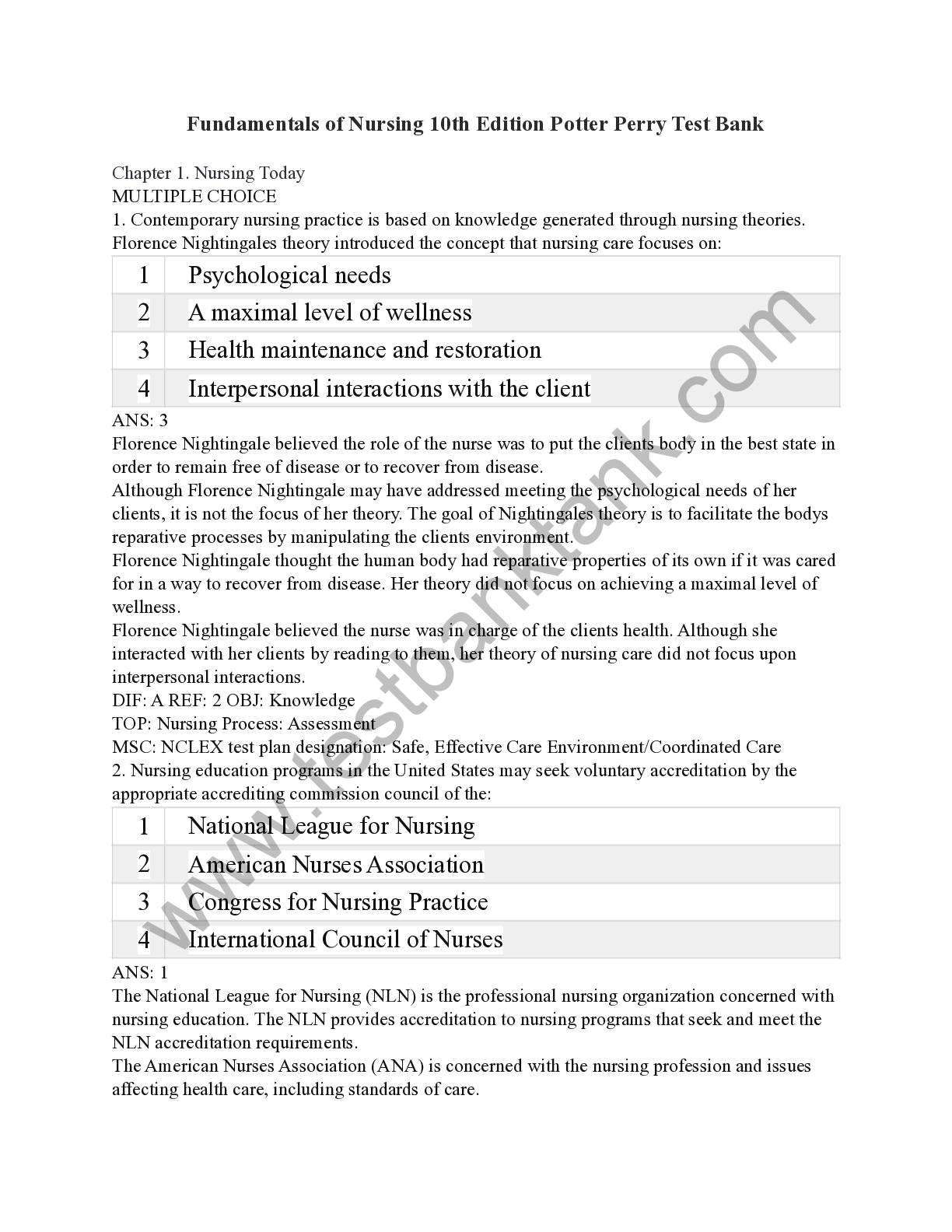
Instant download
Reviews( 2 )

by Chelle · 2 years ago
Sorry for the inconvenience. Let me check [email protected] by Muchiri. 2 years ago

by Muchiri · 2 years ago
Document information
Connected school, study & course
About the document
Uploaded On
Jul 20, 2021
Number of pages
924
Written in
Additional information
This document has been written for:
Uploaded
Jul 20, 2021
Downloads
1
Views
86


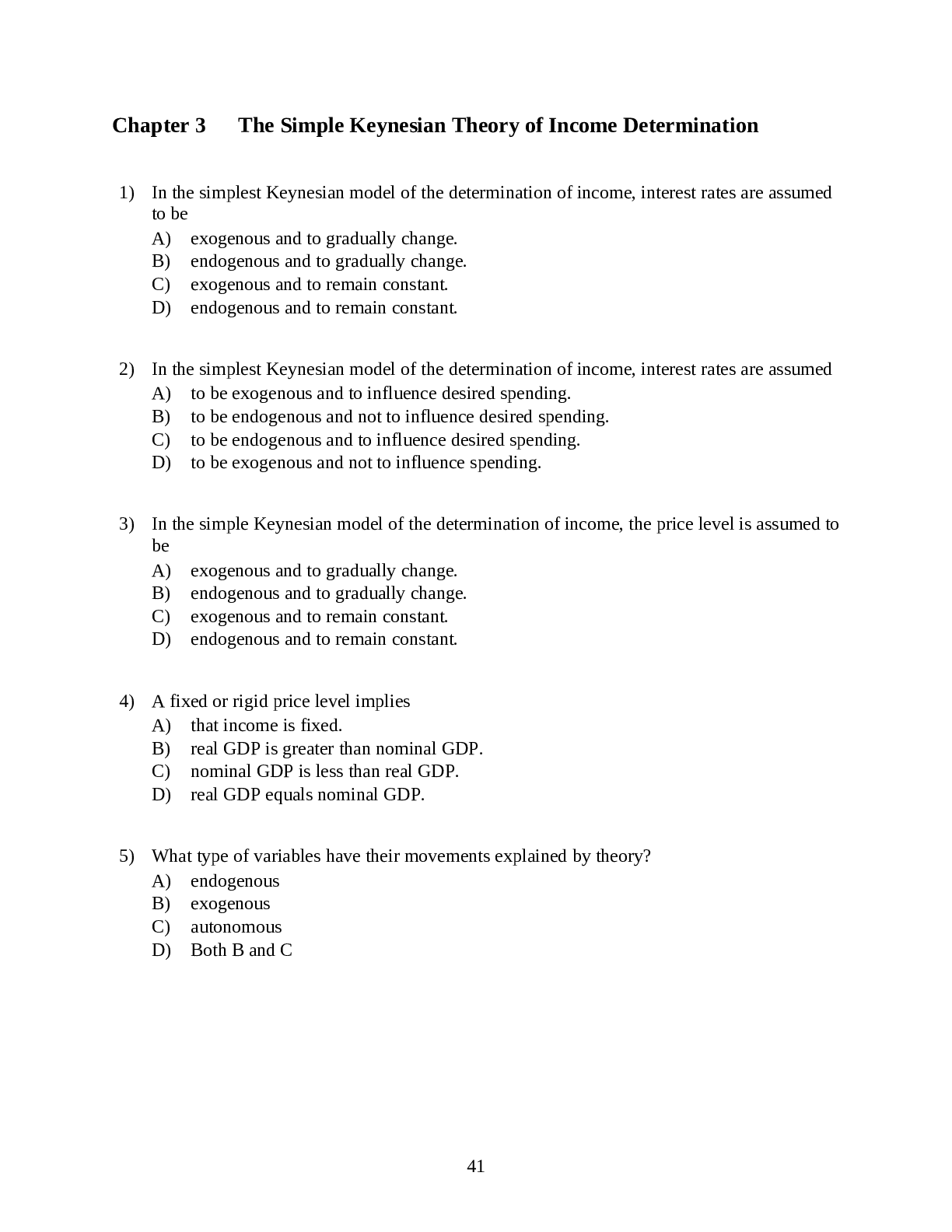

.png)

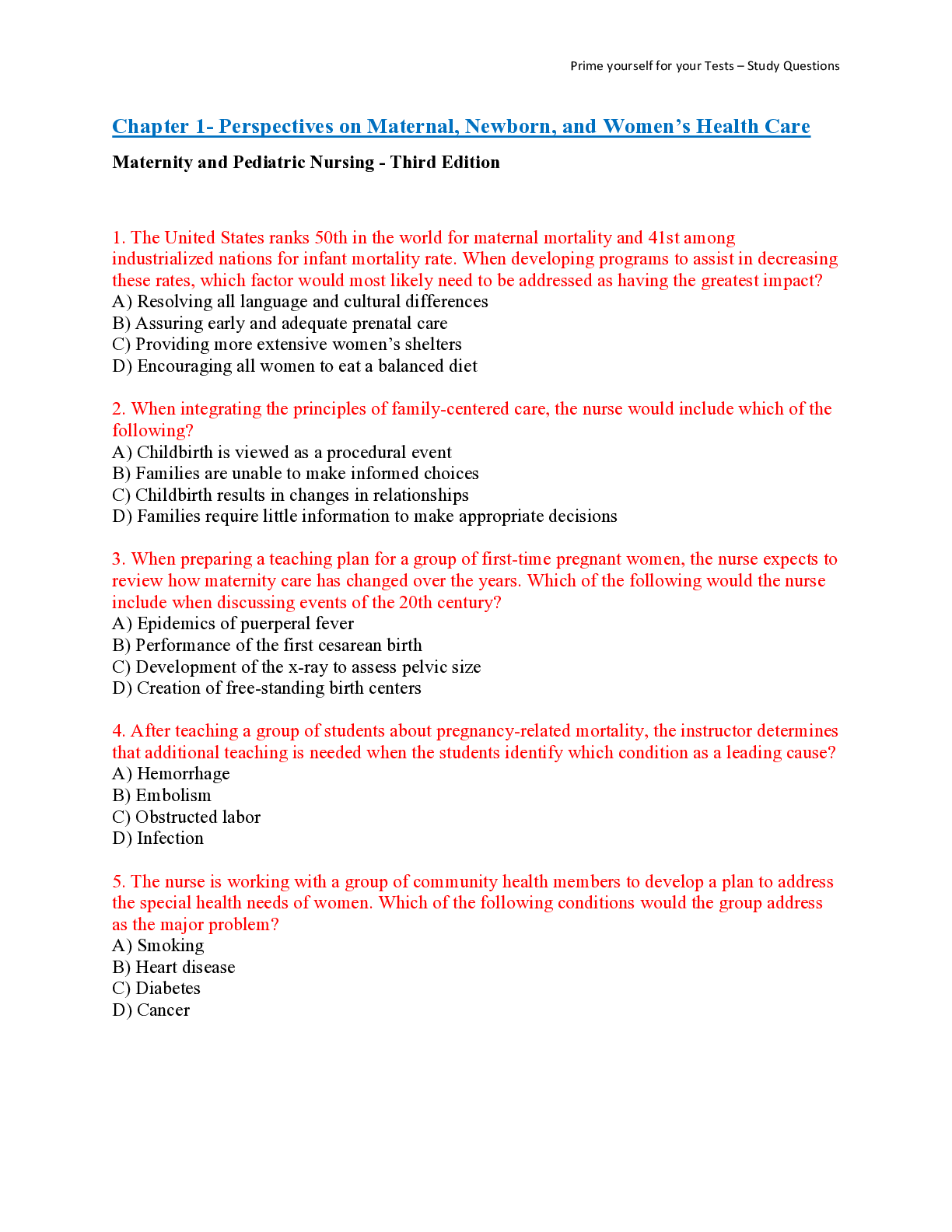
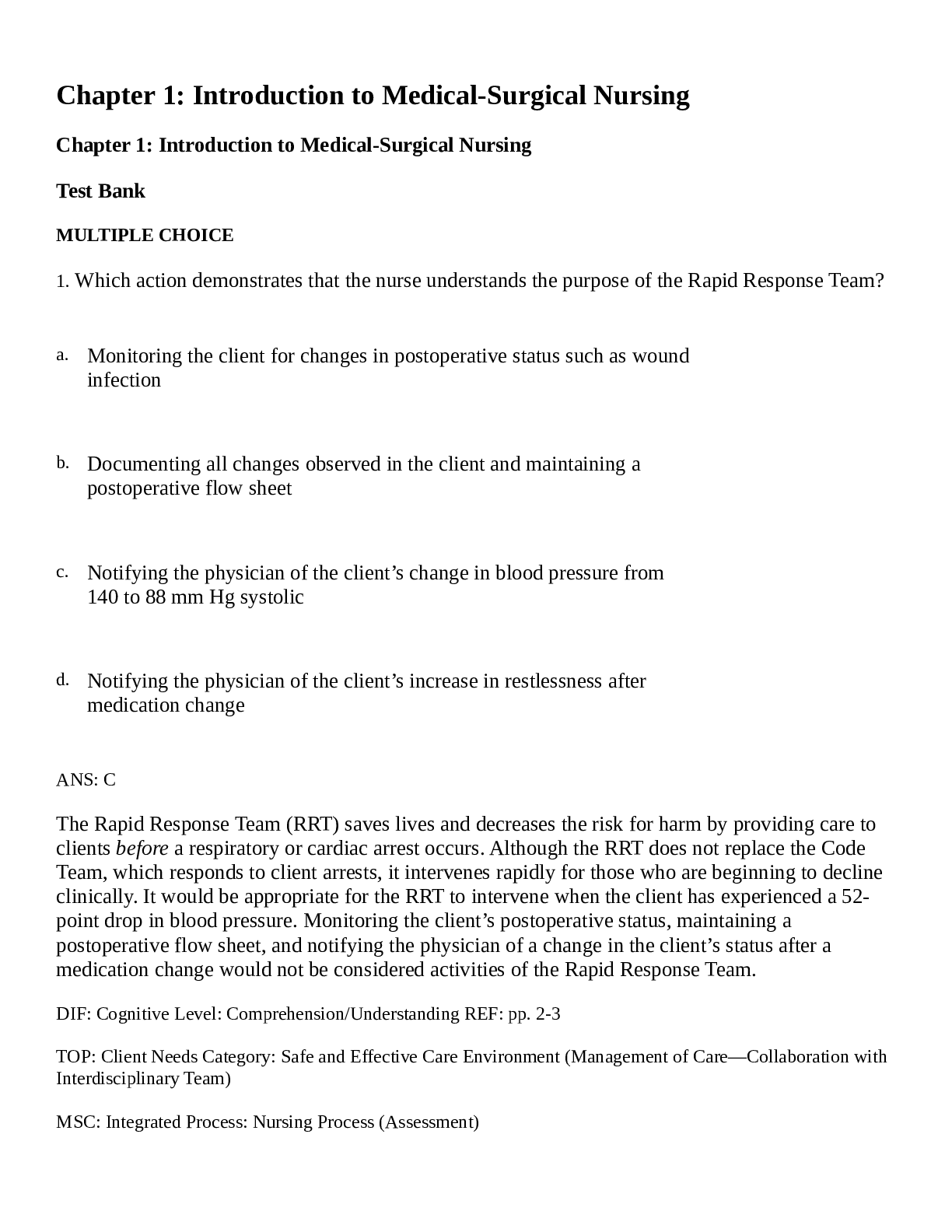

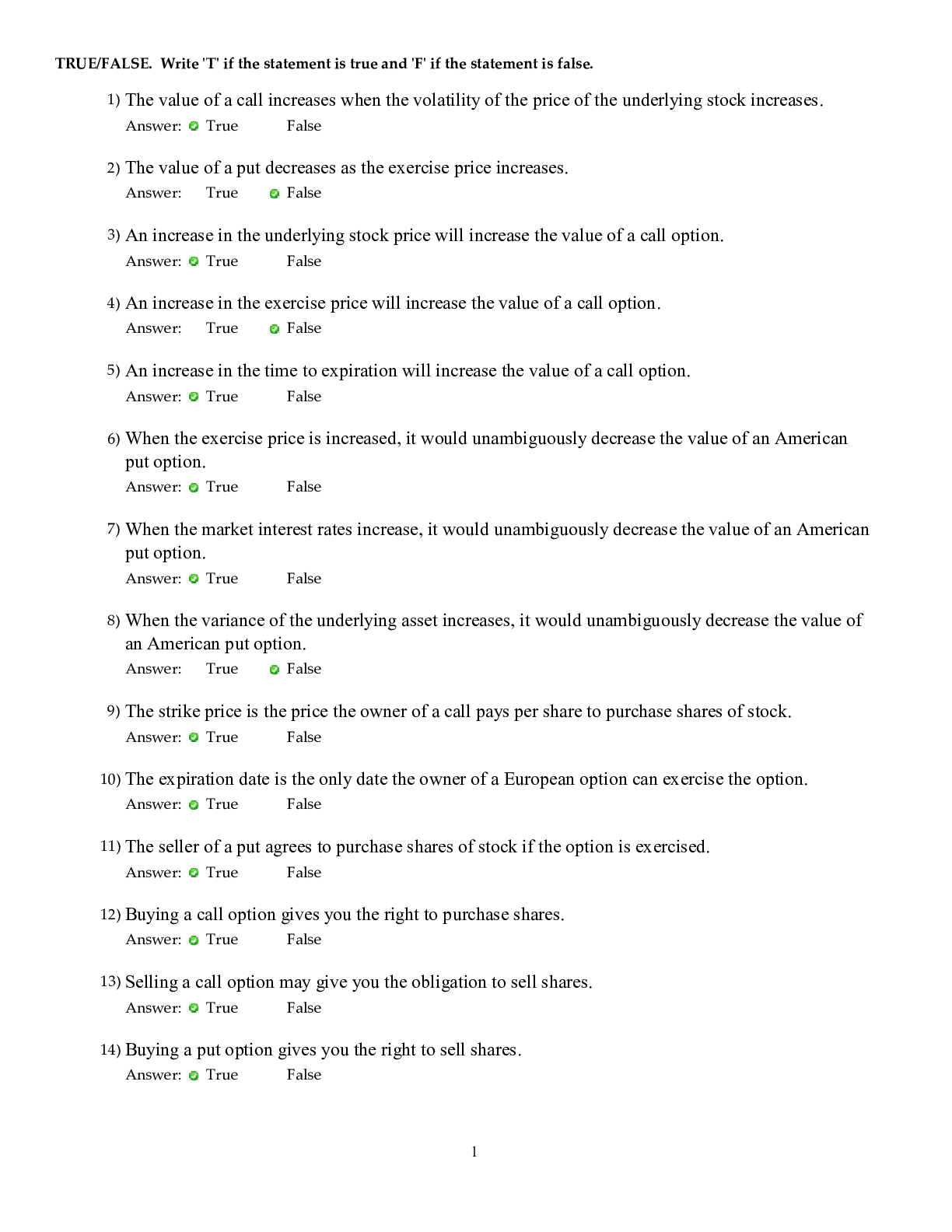

.png)
